Human Resource Management & Performance
VerifiedAdded on 2020/02/05
|27
|4286
|38
AI Summary
This assignment delves into the crucial connection between human resource management (HRM) practices and organizational performance. It requires a comprehensive analysis of relevant research studies, examining how various HRM strategies influence employee attitudes, behaviors, and ultimately, the overall success of organizations. Students are expected to synthesize findings, identify key trends, and discuss the practical implications of these insights for effective HRM implementation.
Contribute Materials
Your contribution can guide someone’s learning journey. Share your
documents today.
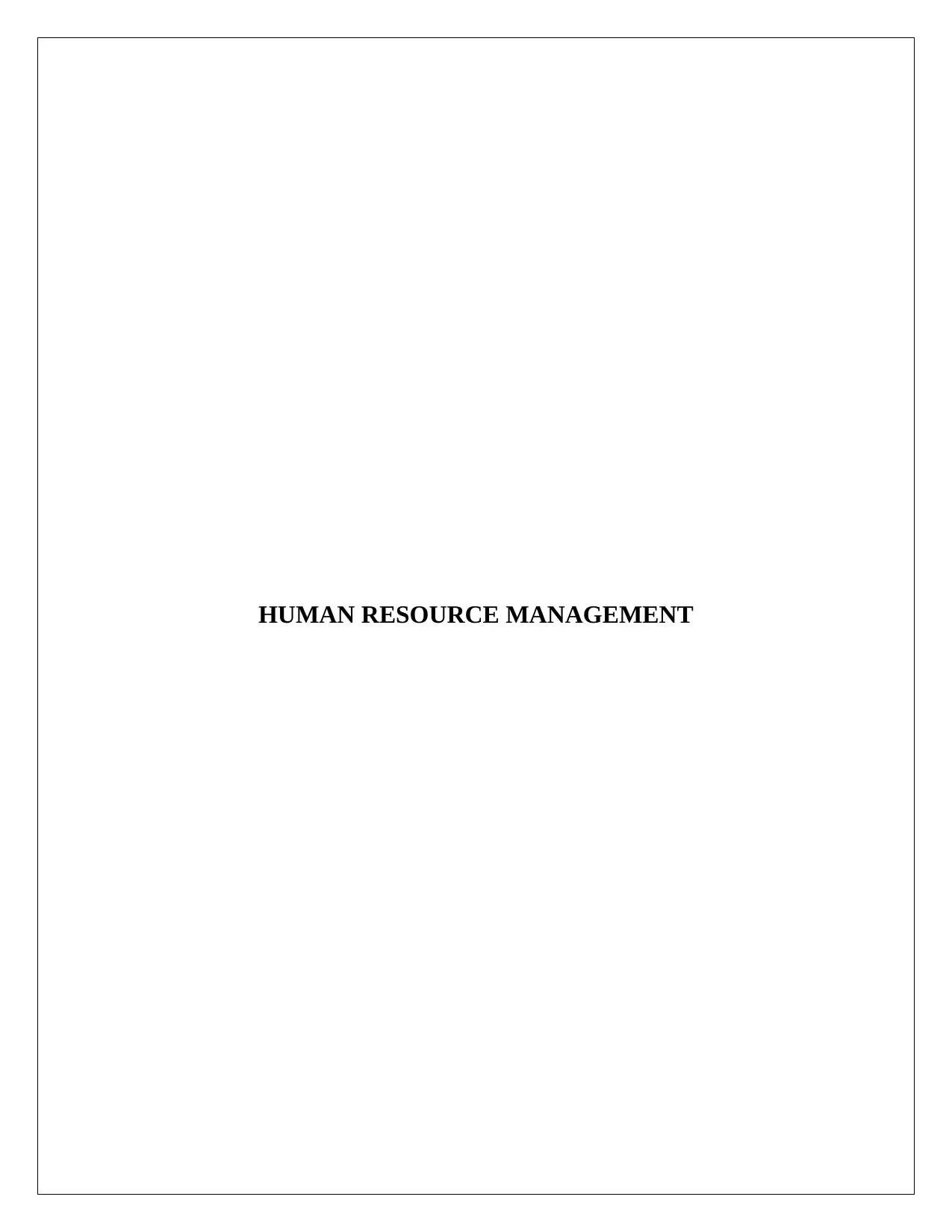
HUMAN RESOURCE MANAGEMENT
Secure Best Marks with AI Grader
Need help grading? Try our AI Grader for instant feedback on your assignments.
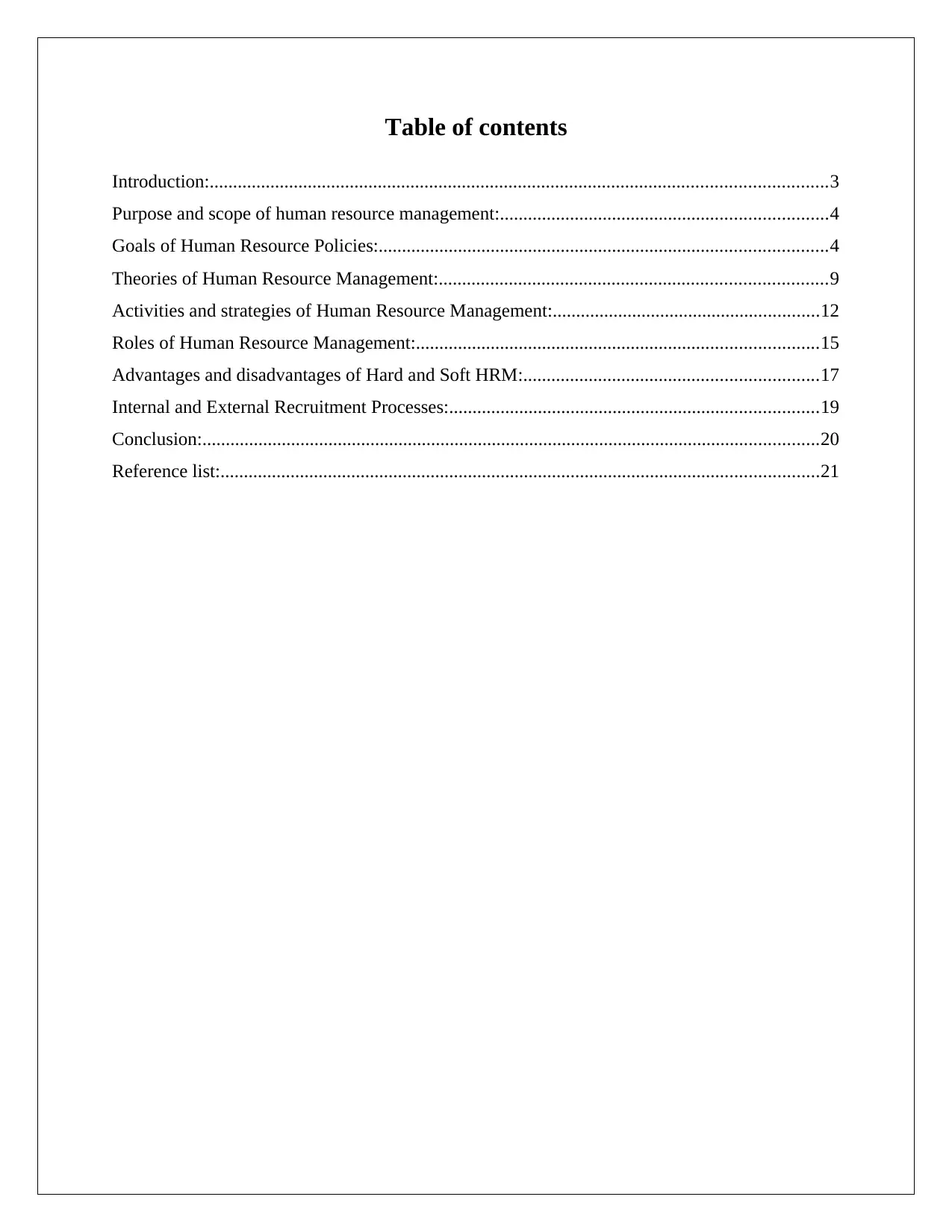
Table of contents
Introduction:....................................................................................................................................3
Purpose and scope of human resource management:......................................................................4
Goals of Human Resource Policies:................................................................................................4
Theories of Human Resource Management:...................................................................................9
Activities and strategies of Human Resource Management:.........................................................12
Roles of Human Resource Management:......................................................................................15
Advantages and disadvantages of Hard and Soft HRM:...............................................................17
Internal and External Recruitment Processes:...............................................................................19
Conclusion:....................................................................................................................................20
Reference list:................................................................................................................................21
Introduction:....................................................................................................................................3
Purpose and scope of human resource management:......................................................................4
Goals of Human Resource Policies:................................................................................................4
Theories of Human Resource Management:...................................................................................9
Activities and strategies of Human Resource Management:.........................................................12
Roles of Human Resource Management:......................................................................................15
Advantages and disadvantages of Hard and Soft HRM:...............................................................17
Internal and External Recruitment Processes:...............................................................................19
Conclusion:....................................................................................................................................20
Reference list:................................................................................................................................21
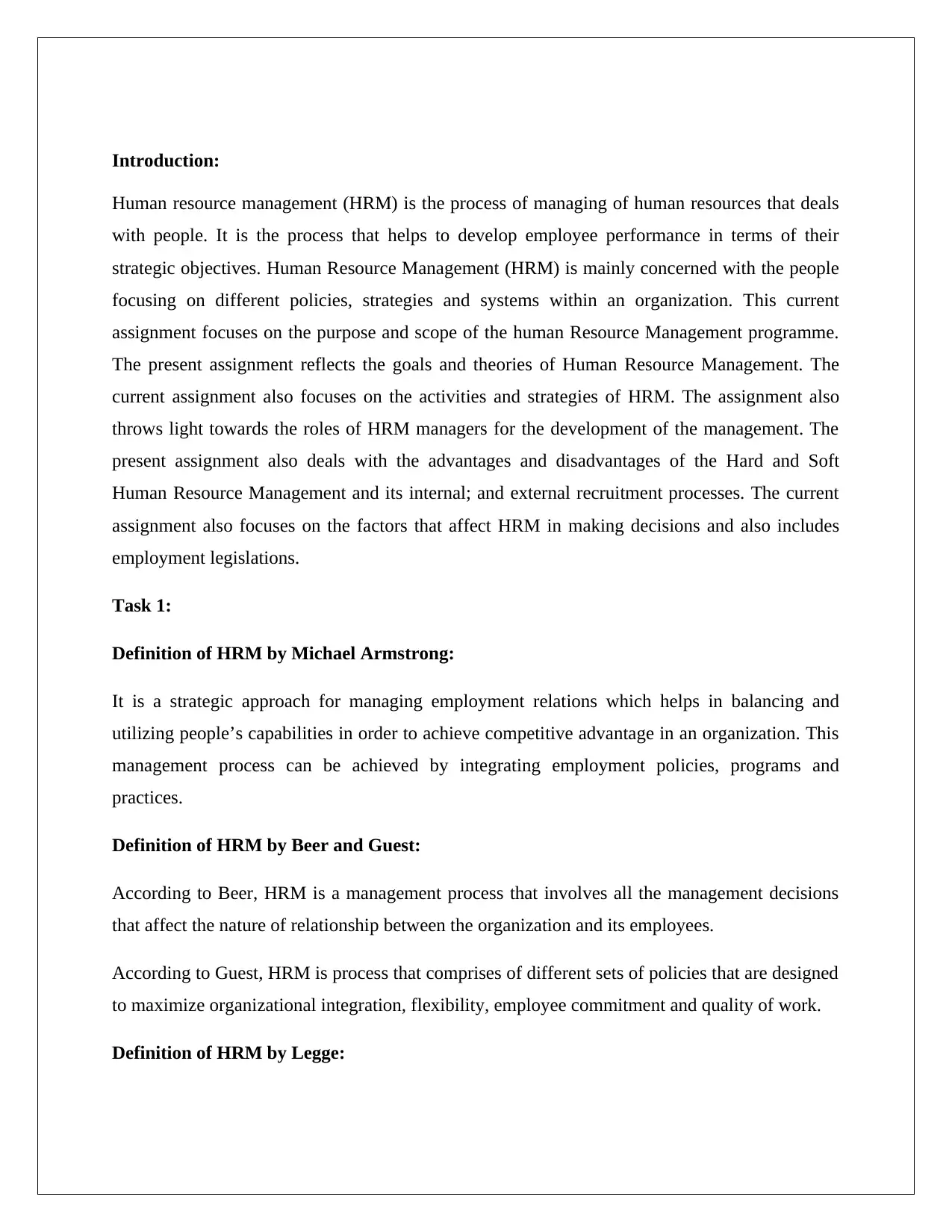
Introduction:
Human resource management (HRM) is the process of managing of human resources that deals
with people. It is the process that helps to develop employee performance in terms of their
strategic objectives. Human Resource Management (HRM) is mainly concerned with the people
focusing on different policies, strategies and systems within an organization. This current
assignment focuses on the purpose and scope of the human Resource Management programme.
The present assignment reflects the goals and theories of Human Resource Management. The
current assignment also focuses on the activities and strategies of HRM. The assignment also
throws light towards the roles of HRM managers for the development of the management. The
present assignment also deals with the advantages and disadvantages of the Hard and Soft
Human Resource Management and its internal; and external recruitment processes. The current
assignment also focuses on the factors that affect HRM in making decisions and also includes
employment legislations.
Task 1:
Definition of HRM by Michael Armstrong:
It is a strategic approach for managing employment relations which helps in balancing and
utilizing people’s capabilities in order to achieve competitive advantage in an organization. This
management process can be achieved by integrating employment policies, programs and
practices.
Definition of HRM by Beer and Guest:
According to Beer, HRM is a management process that involves all the management decisions
that affect the nature of relationship between the organization and its employees.
According to Guest, HRM is process that comprises of different sets of policies that are designed
to maximize organizational integration, flexibility, employee commitment and quality of work.
Definition of HRM by Legge:
Human resource management (HRM) is the process of managing of human resources that deals
with people. It is the process that helps to develop employee performance in terms of their
strategic objectives. Human Resource Management (HRM) is mainly concerned with the people
focusing on different policies, strategies and systems within an organization. This current
assignment focuses on the purpose and scope of the human Resource Management programme.
The present assignment reflects the goals and theories of Human Resource Management. The
current assignment also focuses on the activities and strategies of HRM. The assignment also
throws light towards the roles of HRM managers for the development of the management. The
present assignment also deals with the advantages and disadvantages of the Hard and Soft
Human Resource Management and its internal; and external recruitment processes. The current
assignment also focuses on the factors that affect HRM in making decisions and also includes
employment legislations.
Task 1:
Definition of HRM by Michael Armstrong:
It is a strategic approach for managing employment relations which helps in balancing and
utilizing people’s capabilities in order to achieve competitive advantage in an organization. This
management process can be achieved by integrating employment policies, programs and
practices.
Definition of HRM by Beer and Guest:
According to Beer, HRM is a management process that involves all the management decisions
that affect the nature of relationship between the organization and its employees.
According to Guest, HRM is process that comprises of different sets of policies that are designed
to maximize organizational integration, flexibility, employee commitment and quality of work.
Definition of HRM by Legge:
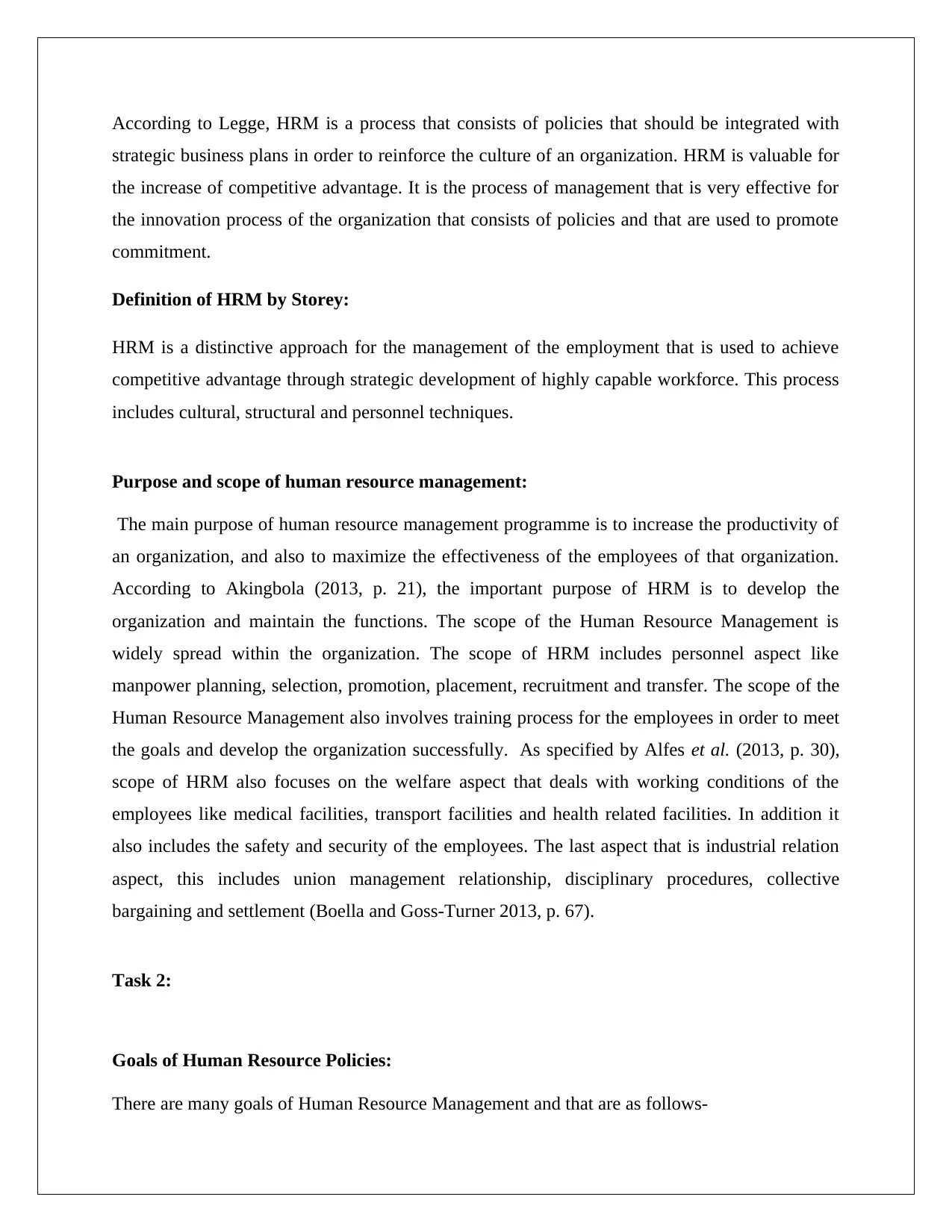
According to Legge, HRM is a process that consists of policies that should be integrated with
strategic business plans in order to reinforce the culture of an organization. HRM is valuable for
the increase of competitive advantage. It is the process of management that is very effective for
the innovation process of the organization that consists of policies and that are used to promote
commitment.
Definition of HRM by Storey:
HRM is a distinctive approach for the management of the employment that is used to achieve
competitive advantage through strategic development of highly capable workforce. This process
includes cultural, structural and personnel techniques.
Purpose and scope of human resource management:
The main purpose of human resource management programme is to increase the productivity of
an organization, and also to maximize the effectiveness of the employees of that organization.
According to Akingbola (2013, p. 21), the important purpose of HRM is to develop the
organization and maintain the functions. The scope of the Human Resource Management is
widely spread within the organization. The scope of HRM includes personnel aspect like
manpower planning, selection, promotion, placement, recruitment and transfer. The scope of the
Human Resource Management also involves training process for the employees in order to meet
the goals and develop the organization successfully. As specified by Alfes et al. (2013, p. 30),
scope of HRM also focuses on the welfare aspect that deals with working conditions of the
employees like medical facilities, transport facilities and health related facilities. In addition it
also includes the safety and security of the employees. The last aspect that is industrial relation
aspect, this includes union management relationship, disciplinary procedures, collective
bargaining and settlement (Boella and Goss-Turner 2013, p. 67).
Task 2:
Goals of Human Resource Policies:
There are many goals of Human Resource Management and that are as follows-
strategic business plans in order to reinforce the culture of an organization. HRM is valuable for
the increase of competitive advantage. It is the process of management that is very effective for
the innovation process of the organization that consists of policies and that are used to promote
commitment.
Definition of HRM by Storey:
HRM is a distinctive approach for the management of the employment that is used to achieve
competitive advantage through strategic development of highly capable workforce. This process
includes cultural, structural and personnel techniques.
Purpose and scope of human resource management:
The main purpose of human resource management programme is to increase the productivity of
an organization, and also to maximize the effectiveness of the employees of that organization.
According to Akingbola (2013, p. 21), the important purpose of HRM is to develop the
organization and maintain the functions. The scope of the Human Resource Management is
widely spread within the organization. The scope of HRM includes personnel aspect like
manpower planning, selection, promotion, placement, recruitment and transfer. The scope of the
Human Resource Management also involves training process for the employees in order to meet
the goals and develop the organization successfully. As specified by Alfes et al. (2013, p. 30),
scope of HRM also focuses on the welfare aspect that deals with working conditions of the
employees like medical facilities, transport facilities and health related facilities. In addition it
also includes the safety and security of the employees. The last aspect that is industrial relation
aspect, this includes union management relationship, disciplinary procedures, collective
bargaining and settlement (Boella and Goss-Turner 2013, p. 67).
Task 2:
Goals of Human Resource Policies:
There are many goals of Human Resource Management and that are as follows-
Secure Best Marks with AI Grader
Need help grading? Try our AI Grader for instant feedback on your assignments.
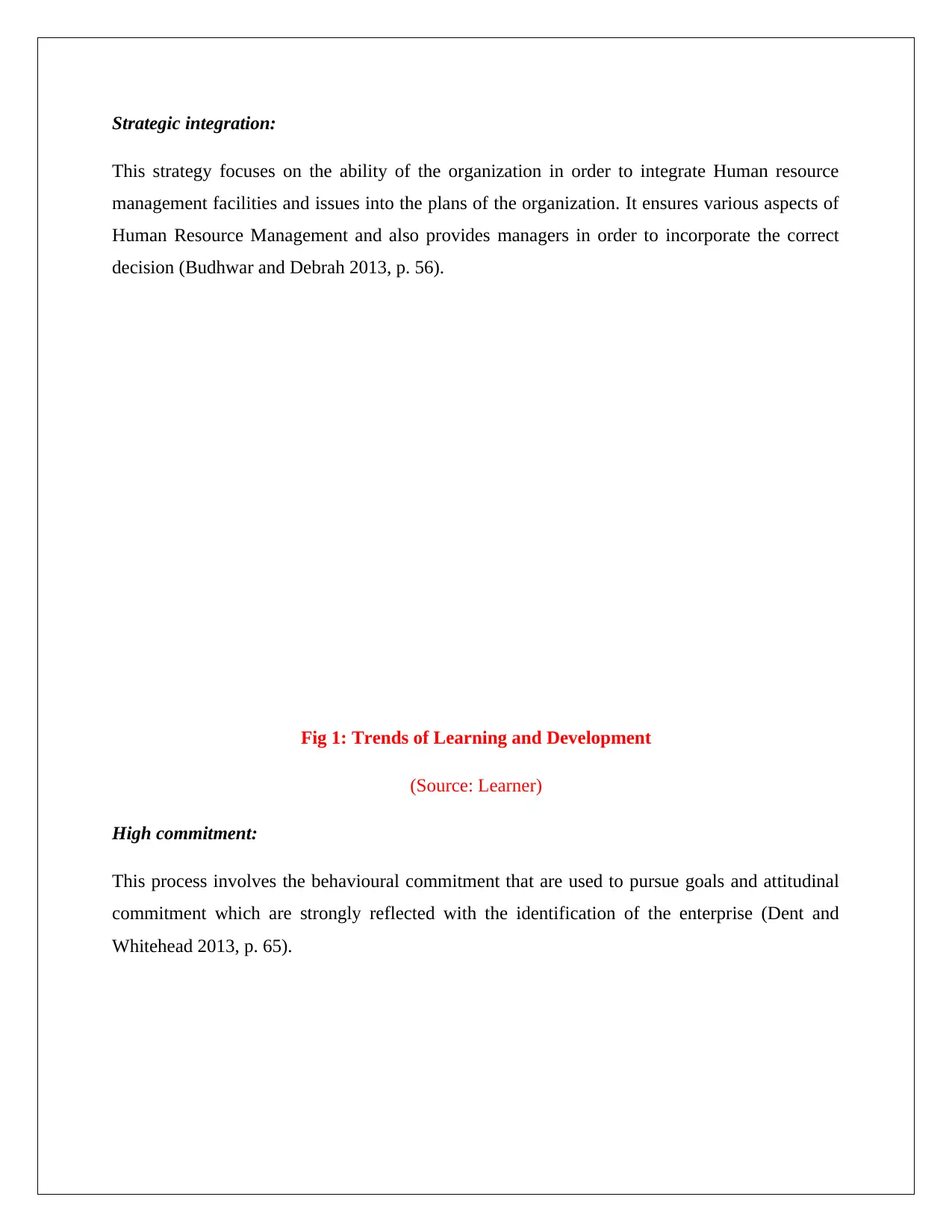
Strategic integration:
This strategy focuses on the ability of the organization in order to integrate Human resource
management facilities and issues into the plans of the organization. It ensures various aspects of
Human Resource Management and also provides managers in order to incorporate the correct
decision (Budhwar and Debrah 2013, p. 56).
Fig 1: Trends of Learning and Development
(Source: Learner)
High commitment:
This process involves the behavioural commitment that are used to pursue goals and attitudinal
commitment which are strongly reflected with the identification of the enterprise (Dent and
Whitehead 2013, p. 65).
On-the-jobtraining,in-housedevelopmentprogrammesandcoachingbylinemanagers.Theyaremorelikelythansmallerorganisationstoincludee-learningcourses.CloserintegrationofLearningandDevelopmentactivityandbusinessstrategyisanticipated.
This strategy focuses on the ability of the organization in order to integrate Human resource
management facilities and issues into the plans of the organization. It ensures various aspects of
Human Resource Management and also provides managers in order to incorporate the correct
decision (Budhwar and Debrah 2013, p. 56).
Fig 1: Trends of Learning and Development
(Source: Learner)
High commitment:
This process involves the behavioural commitment that are used to pursue goals and attitudinal
commitment which are strongly reflected with the identification of the enterprise (Dent and
Whitehead 2013, p. 65).
On-the-jobtraining,in-housedevelopmentprogrammesandcoachingbylinemanagers.Theyaremorelikelythansmallerorganisationstoincludee-learningcourses.CloserintegrationofLearningandDevelopmentactivityandbusinessstrategyisanticipated.

Figure 2: Process of learning and development
(Source: Learner)
High quality:
This strategy includes all the functions and activities of the managerial aspects. This also helps in
determining the quality of goods and services that are provided, and also includes management
for the employees. According to Dries (2013, p. 72), in order to maintain high quality products it
requires high quality investments for the employees.
Flexibility:
Flexibility determines the functional flexibility of the organizations and it also focuses on the
existence of an adaptable structure of organization in order to manage innovation (Grönroos and
Voima 2013, p. 33).
(Source: Learner)
High quality:
This strategy includes all the functions and activities of the managerial aspects. This also helps in
determining the quality of goods and services that are provided, and also includes management
for the employees. According to Dries (2013, p. 72), in order to maintain high quality products it
requires high quality investments for the employees.
Flexibility:
Flexibility determines the functional flexibility of the organizations and it also focuses on the
existence of an adaptable structure of organization in order to manage innovation (Grönroos and
Voima 2013, p. 33).
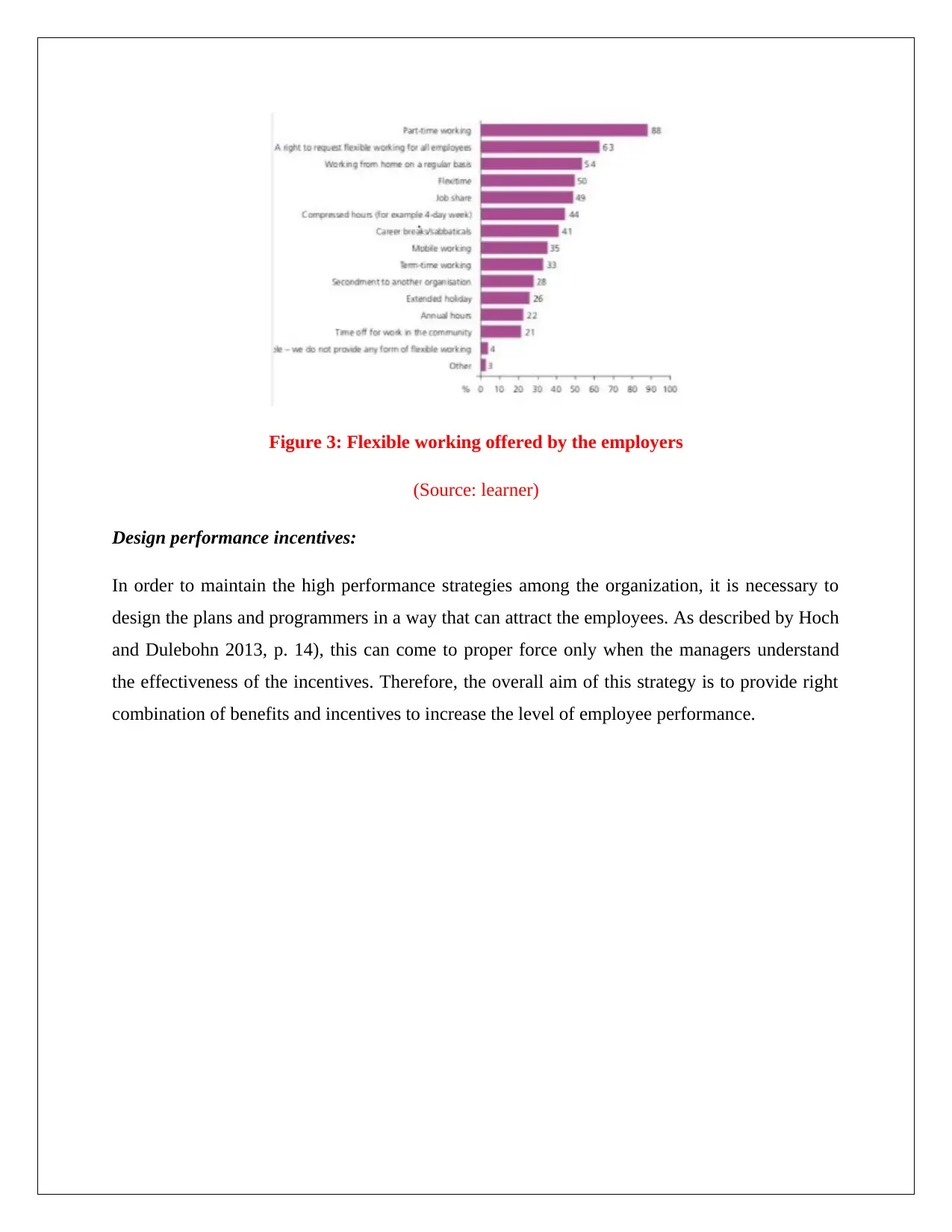
Figure 3: Flexible working offered by the employers
(Source: learner)
Design performance incentives:
In order to maintain the high performance strategies among the organization, it is necessary to
design the plans and programmers in a way that can attract the employees. As described by Hoch
and Dulebohn 2013, p. 14), this can come to proper force only when the managers understand
the effectiveness of the incentives. Therefore, the overall aim of this strategy is to provide right
combination of benefits and incentives to increase the level of employee performance.
(Source: learner)
Design performance incentives:
In order to maintain the high performance strategies among the organization, it is necessary to
design the plans and programmers in a way that can attract the employees. As described by Hoch
and Dulebohn 2013, p. 14), this can come to proper force only when the managers understand
the effectiveness of the incentives. Therefore, the overall aim of this strategy is to provide right
combination of benefits and incentives to increase the level of employee performance.
Paraphrase This Document
Need a fresh take? Get an instant paraphrase of this document with our AI Paraphraser
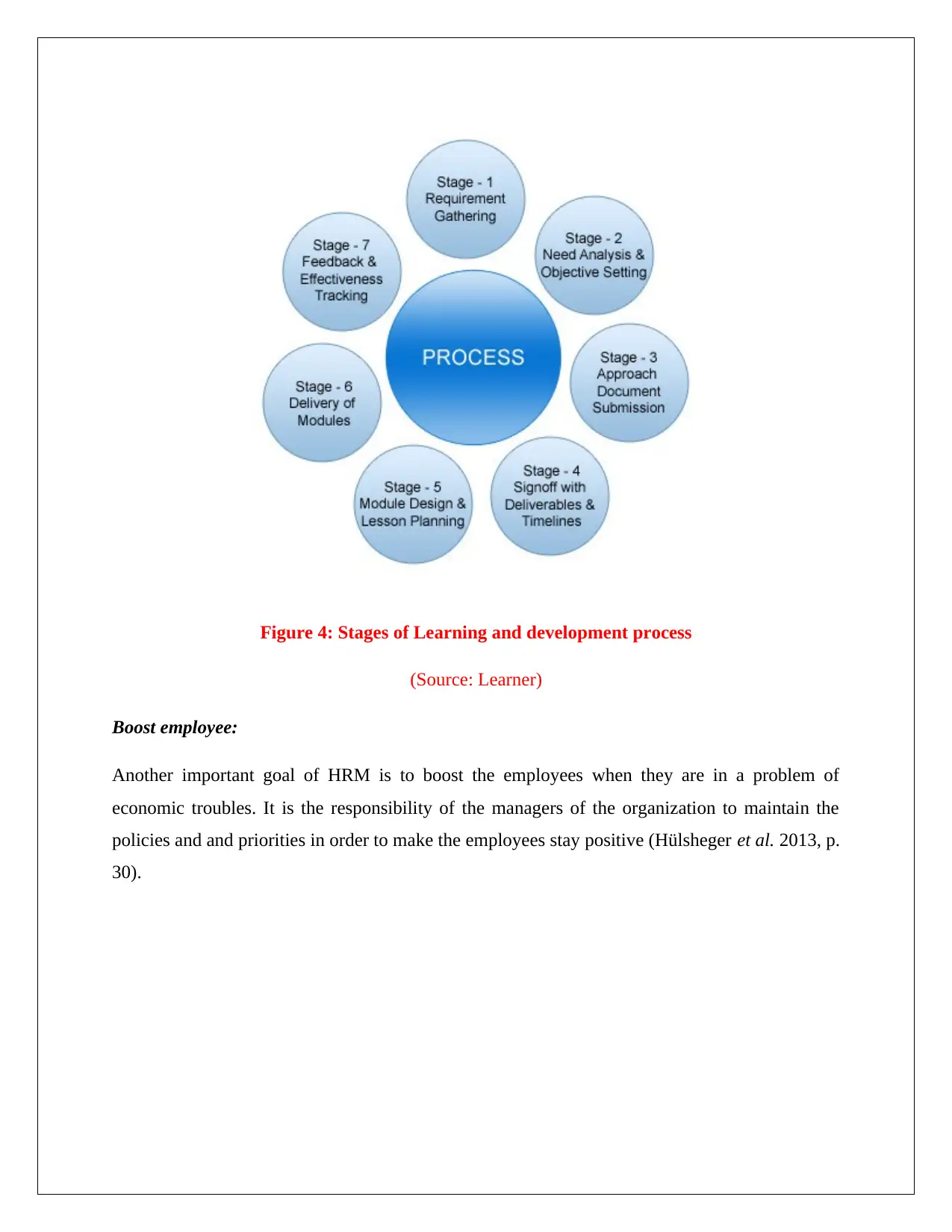
Figure 4: Stages of Learning and development process
(Source: Learner)
Boost employee:
Another important goal of HRM is to boost the employees when they are in a problem of
economic troubles. It is the responsibility of the managers of the organization to maintain the
policies and and priorities in order to make the employees stay positive (Hülsheger et al. 2013, p.
30).
(Source: Learner)
Boost employee:
Another important goal of HRM is to boost the employees when they are in a problem of
economic troubles. It is the responsibility of the managers of the organization to maintain the
policies and and priorities in order to make the employees stay positive (Hülsheger et al. 2013, p.
30).

Figure 5: learning and development process
(Source: Created by the Learner)
Increase accountability:
This goal focuses on the effectiveness of the personnel practices in order to make a business
quantified and help the employees to explore their desired behaviours.
Development of leaders:
It is very important to maintain the priorities to develop leadership qualities especially for the
future leaders. According to Jabbour et al, (2013, p. 29), this process requires huge support from
the managers and HR to provide proper training and make them professional leaders. Leaders
need proper way to increase their responsibilities.
TALENTMANAGEMENT:ITISAPROCESSTOINCREASETHEKNOWLEDGEANDIDENTIFYTHETALENTINAPARTICULARINDIVIDUAL.LEADERSHIPDEVELOPMENT:ITISAPROCESSTHATHELPSINDEVELOPMENTOFTHEBUSINESSORGANISATIONBYDEVELOPINGTHELEADERS.LEARNINGTECHNOLOGIES:ITISTHEPROCESSTOLEARNWITHTHEHELPOFNEWTECHNOLOGIESANDSYSTEMS.
(Source: Created by the Learner)
Increase accountability:
This goal focuses on the effectiveness of the personnel practices in order to make a business
quantified and help the employees to explore their desired behaviours.
Development of leaders:
It is very important to maintain the priorities to develop leadership qualities especially for the
future leaders. According to Jabbour et al, (2013, p. 29), this process requires huge support from
the managers and HR to provide proper training and make them professional leaders. Leaders
need proper way to increase their responsibilities.
TALENTMANAGEMENT:ITISAPROCESSTOINCREASETHEKNOWLEDGEANDIDENTIFYTHETALENTINAPARTICULARINDIVIDUAL.LEADERSHIPDEVELOPMENT:ITISAPROCESSTHATHELPSINDEVELOPMENTOFTHEBUSINESSORGANISATIONBYDEVELOPINGTHELEADERS.LEARNINGTECHNOLOGIES:ITISTHEPROCESSTOLEARNWITHTHEHELPOFNEWTECHNOLOGIESANDSYSTEMS.
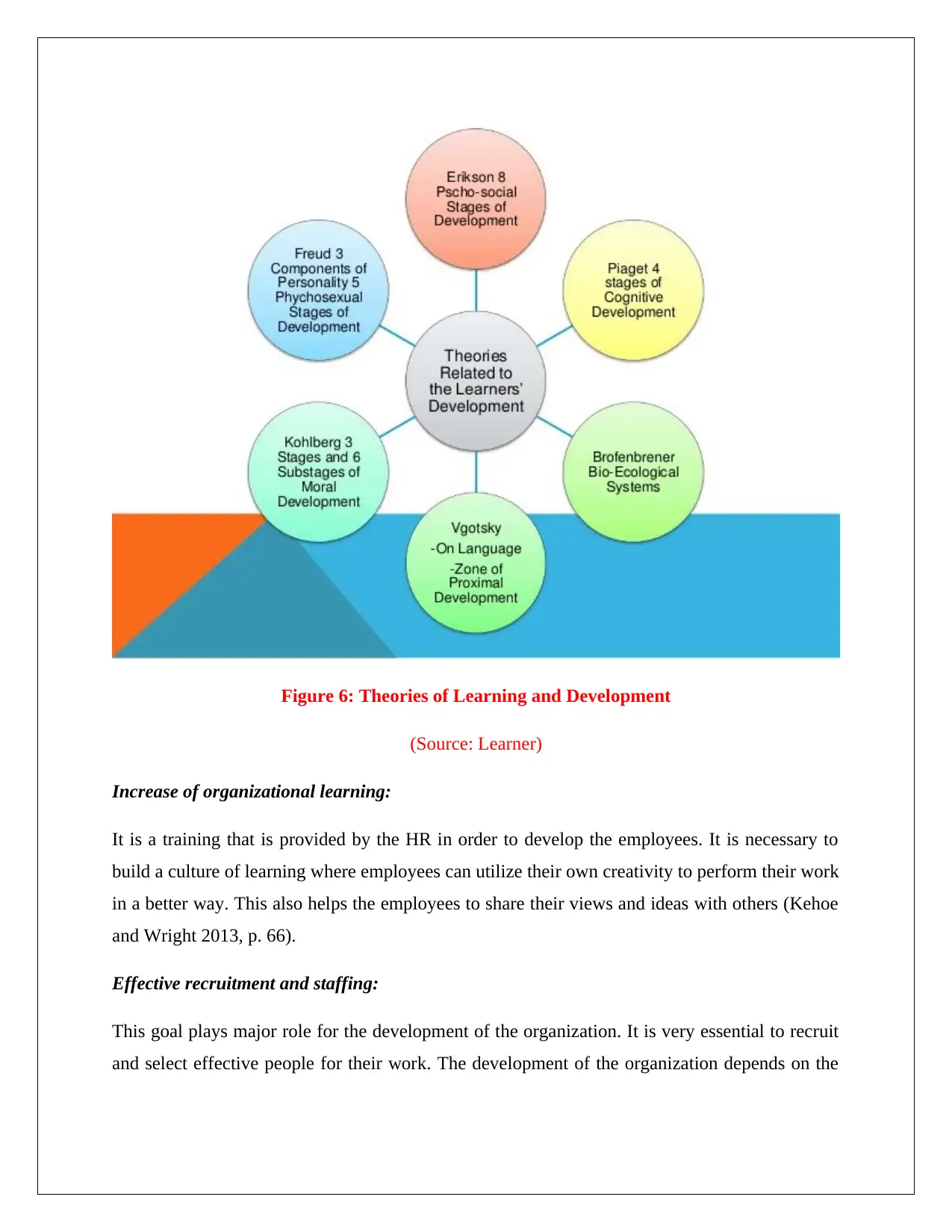
Figure 6: Theories of Learning and Development
(Source: Learner)
Increase of organizational learning:
It is a training that is provided by the HR in order to develop the employees. It is necessary to
build a culture of learning where employees can utilize their own creativity to perform their work
in a better way. This also helps the employees to share their views and ideas with others (Kehoe
and Wright 2013, p. 66).
Effective recruitment and staffing:
This goal plays major role for the development of the organization. It is very essential to recruit
and select effective people for their work. The development of the organization depends on the
(Source: Learner)
Increase of organizational learning:
It is a training that is provided by the HR in order to develop the employees. It is necessary to
build a culture of learning where employees can utilize their own creativity to perform their work
in a better way. This also helps the employees to share their views and ideas with others (Kehoe
and Wright 2013, p. 66).
Effective recruitment and staffing:
This goal plays major role for the development of the organization. It is very essential to recruit
and select effective people for their work. The development of the organization depends on the
Secure Best Marks with AI Grader
Need help grading? Try our AI Grader for instant feedback on your assignments.
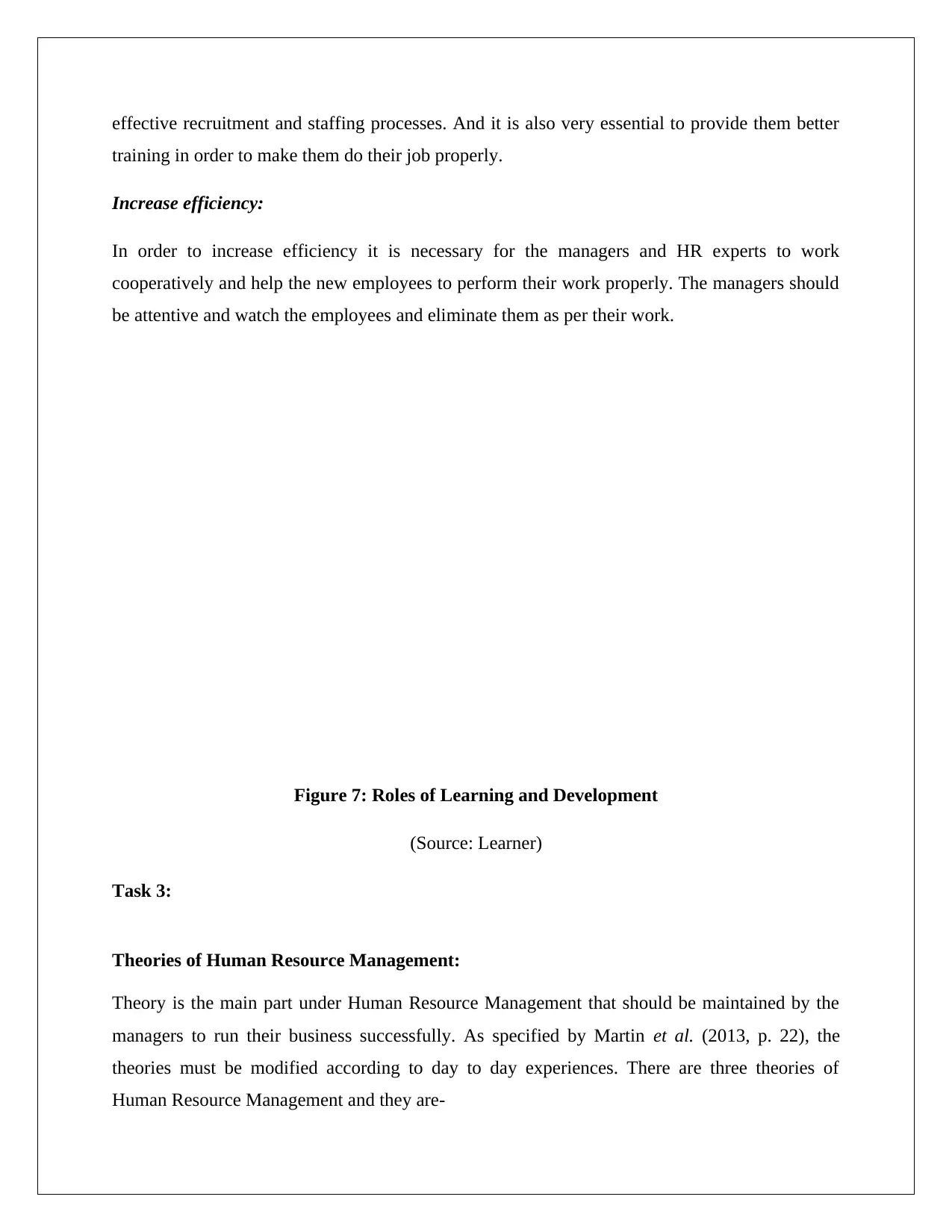
effective recruitment and staffing processes. And it is also very essential to provide them better
training in order to make them do their job properly.
Increase efficiency:
In order to increase efficiency it is necessary for the managers and HR experts to work
cooperatively and help the new employees to perform their work properly. The managers should
be attentive and watch the employees and eliminate them as per their work.
Figure 7: Roles of Learning and Development
(Source: Learner)
Task 3:
Theories of Human Resource Management:
Theory is the main part under Human Resource Management that should be maintained by the
managers to run their business successfully. As specified by Martin et al. (2013, p. 22), the
theories must be modified according to day to day experiences. There are three theories of
Human Resource Management and they are-
ROLESOFLEARNINGANDDEVELOPMENT
training in order to make them do their job properly.
Increase efficiency:
In order to increase efficiency it is necessary for the managers and HR experts to work
cooperatively and help the new employees to perform their work properly. The managers should
be attentive and watch the employees and eliminate them as per their work.
Figure 7: Roles of Learning and Development
(Source: Learner)
Task 3:
Theories of Human Resource Management:
Theory is the main part under Human Resource Management that should be maintained by the
managers to run their business successfully. As specified by Martin et al. (2013, p. 22), the
theories must be modified according to day to day experiences. There are three theories of
Human Resource Management and they are-
ROLESOFLEARNINGANDDEVELOPMENT
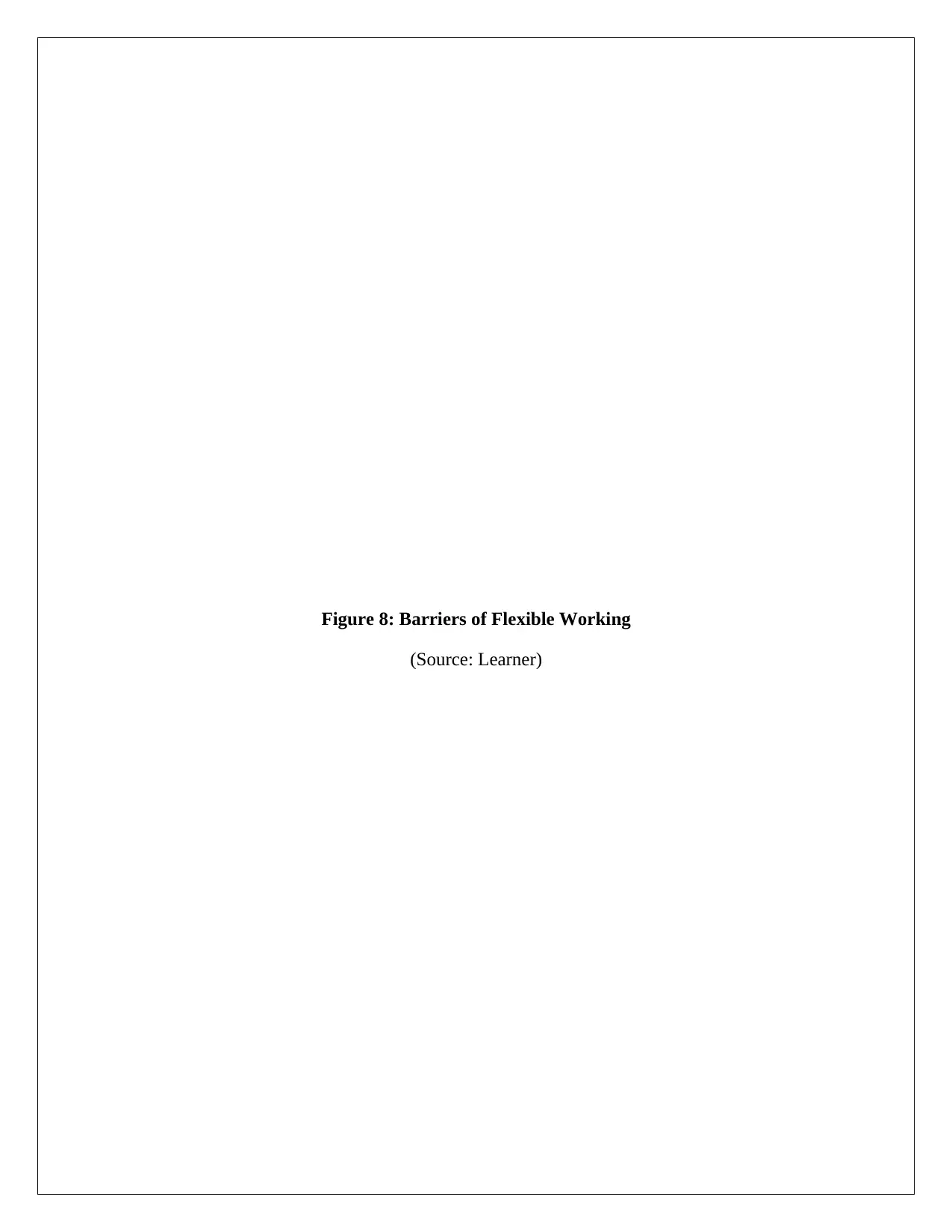
Figure 8: Barriers of Flexible Working
(Source: Learner)
BARRIERSOFFLEXIBLEWORKINGThemainbarriertoimprovingflexibleworkingappearstobeoperationalpressures,whichwasmentionedby52%ofemployers.Accordingtoemployees,thebiggestobstacletoflexibleworkingisthenatureoftheworktheydo,with34%citingthisasanissue
(Source: Learner)
BARRIERSOFFLEXIBLEWORKINGThemainbarriertoimprovingflexibleworkingappearstobeoperationalpressures,whichwasmentionedby52%ofemployers.Accordingtoemployees,thebiggestobstacletoflexibleworkingisthenatureoftheworktheydo,with34%citingthisasanissue
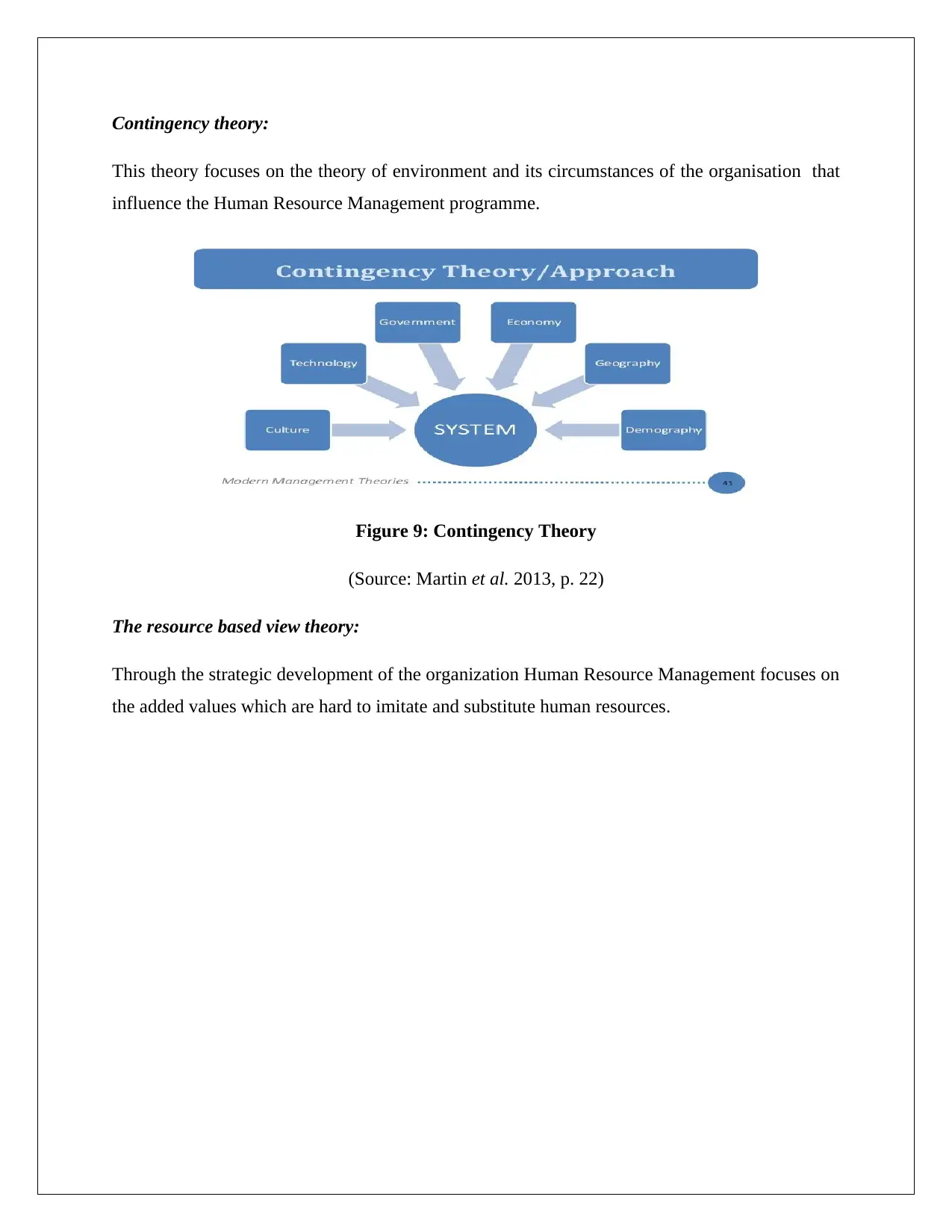
Contingency theory:
This theory focuses on the theory of environment and its circumstances of the organisation that
influence the Human Resource Management programme.
Figure 9: Contingency Theory
(Source: Martin et al. 2013, p. 22)
The resource based view theory:
Through the strategic development of the organization Human Resource Management focuses on
the added values which are hard to imitate and substitute human resources.
This theory focuses on the theory of environment and its circumstances of the organisation that
influence the Human Resource Management programme.
Figure 9: Contingency Theory
(Source: Martin et al. 2013, p. 22)
The resource based view theory:
Through the strategic development of the organization Human Resource Management focuses on
the added values which are hard to imitate and substitute human resources.
Paraphrase This Document
Need a fresh take? Get an instant paraphrase of this document with our AI Paraphraser
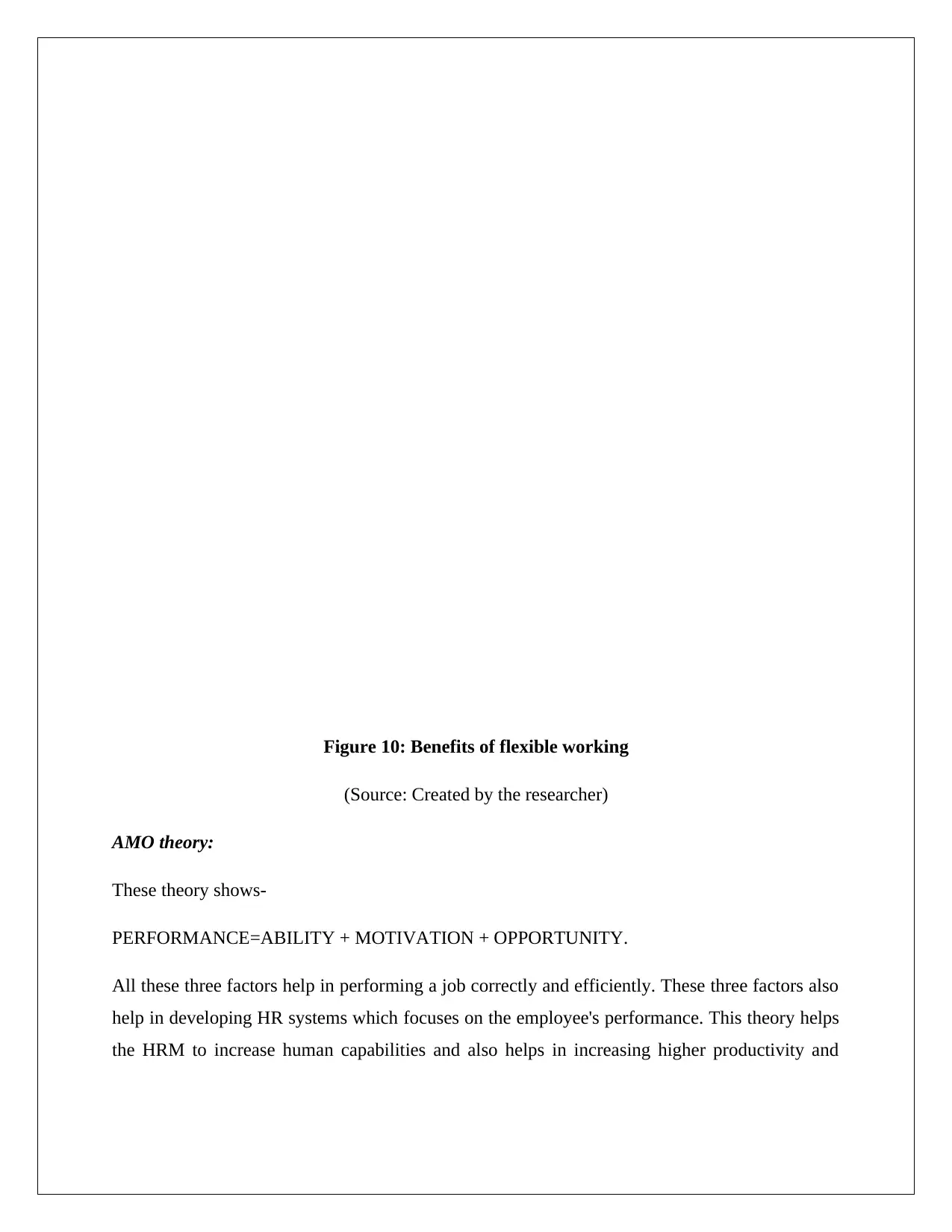
Figure 10: Benefits of flexible working
(Source: Created by the researcher)
AMO theory:
These theory shows-
PERFORMANCE=ABILITY + MOTIVATION + OPPORTUNITY.
All these three factors help in performing a job correctly and efficiently. These three factors also
help in developing HR systems which focuses on the employee's performance. This theory helps
the HRM to increase human capabilities and also helps in increasing higher productivity and
BENIFITSOFFLEXIBLEWORKINGWORKFROMHOME:ITISTHEPROCESSOFWORKINGTHATPROVIDESFLEXIBLEWORKINGPROVISIONTOTHEEMPLOYEESBALANCEWORKLIFE:ITMAINTYAIONSTHEBALANCEBETWEENTHEPERSONALANDPROFESSIONALLIFE.MOREPRODUCTIVITY:ITPROVIDESFREEDOMINWORKANDRELAXEDENVIRONMENT
(Source: Created by the researcher)
AMO theory:
These theory shows-
PERFORMANCE=ABILITY + MOTIVATION + OPPORTUNITY.
All these three factors help in performing a job correctly and efficiently. These three factors also
help in developing HR systems which focuses on the employee's performance. This theory helps
the HRM to increase human capabilities and also helps in increasing higher productivity and
BENIFITSOFFLEXIBLEWORKINGWORKFROMHOME:ITISTHEPROCESSOFWORKINGTHATPROVIDESFLEXIBLEWORKINGPROVISIONTOTHEEMPLOYEESBALANCEWORKLIFE:ITMAINTYAIONSTHEBALANCEBETWEENTHEPERSONALANDPROFESSIONALLIFE.MOREPRODUCTIVITY:ITPROVIDESFREEDOMINWORKANDRELAXEDENVIRONMENT

reducing waste. According to this theory HRM performs their duties by enhancing employee's
ability and opportunity (Messersmith and Wales 2013, p. 15).
Figure 11: Types of flexibility
(Source: Learner)
Task 4:
Activities and strategies of Human Resource Management:
The activities, strategies and functions of Human Resource Management include the following
processes in order to fulfil their functions. This includes the managerial activities as well as the
operative activities.
Managerial activities-
Planning:
TYPESOFFLEXIBLEWORKINGFORMALITMAINTAINSREGULARITYINFORMALITHASNOPROVISIONFORREGULARITY
ability and opportunity (Messersmith and Wales 2013, p. 15).
Figure 11: Types of flexibility
(Source: Learner)
Task 4:
Activities and strategies of Human Resource Management:
The activities, strategies and functions of Human Resource Management include the following
processes in order to fulfil their functions. This includes the managerial activities as well as the
operative activities.
Managerial activities-
Planning:
TYPESOFFLEXIBLEWORKINGFORMALITMAINTAINSREGULARITYINFORMALITHASNOPROVISIONFORREGULARITY

Managerial planning includes the goals and policies for an organization. The plans are made to
formulate the programmers and helps in achieving the targeted goals. Forecasting plays a major
role in the planning process.
Figure 12: Activities of HRM
(Source: Mitchell, 2013, p. 44)
Organizing:
It is a process of determining and allocating the perfect jobs to the suitable employees. This
process includes specific task for specific employees in order to fulfil their goals. Coordination
cooperation is the main point that helps in organizing task successfully (Mitchell 2013, p. 44).
Staffing:
formulate the programmers and helps in achieving the targeted goals. Forecasting plays a major
role in the planning process.
Figure 12: Activities of HRM
(Source: Mitchell, 2013, p. 44)
Organizing:
It is a process of determining and allocating the perfect jobs to the suitable employees. This
process includes specific task for specific employees in order to fulfil their goals. Coordination
cooperation is the main point that helps in organizing task successfully (Mitchell 2013, p. 44).
Staffing:
Secure Best Marks with AI Grader
Need help grading? Try our AI Grader for instant feedback on your assignments.
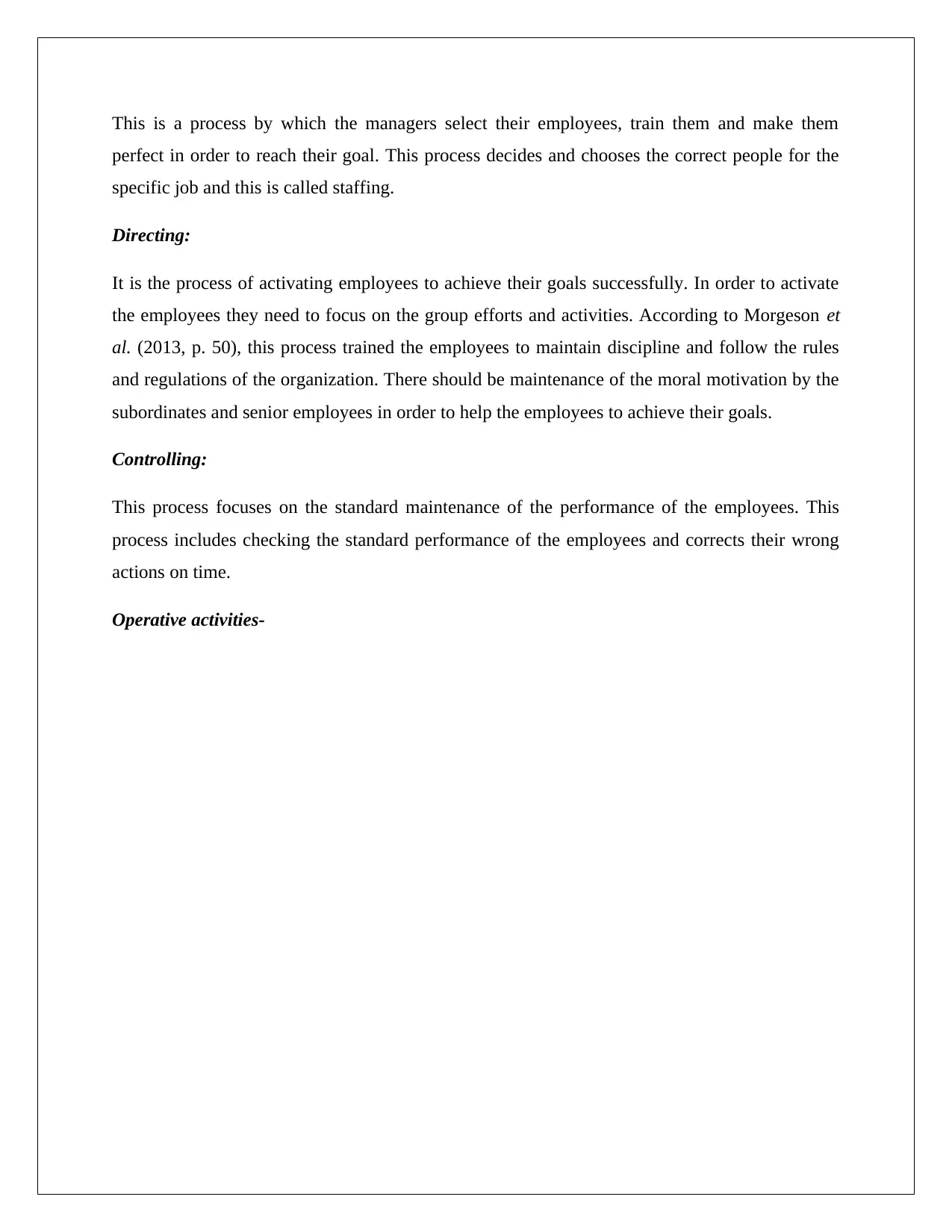
This is a process by which the managers select their employees, train them and make them
perfect in order to reach their goal. This process decides and chooses the correct people for the
specific job and this is called staffing.
Directing:
It is the process of activating employees to achieve their goals successfully. In order to activate
the employees they need to focus on the group efforts and activities. According to Morgeson et
al. (2013, p. 50), this process trained the employees to maintain discipline and follow the rules
and regulations of the organization. There should be maintenance of the moral motivation by the
subordinates and senior employees in order to help the employees to achieve their goals.
Controlling:
This process focuses on the standard maintenance of the performance of the employees. This
process includes checking the standard performance of the employees and corrects their wrong
actions on time.
Operative activities-
OPERATIVEACTIVITIES
perfect in order to reach their goal. This process decides and chooses the correct people for the
specific job and this is called staffing.
Directing:
It is the process of activating employees to achieve their goals successfully. In order to activate
the employees they need to focus on the group efforts and activities. According to Morgeson et
al. (2013, p. 50), this process trained the employees to maintain discipline and follow the rules
and regulations of the organization. There should be maintenance of the moral motivation by the
subordinates and senior employees in order to help the employees to achieve their goals.
Controlling:
This process focuses on the standard maintenance of the performance of the employees. This
process includes checking the standard performance of the employees and corrects their wrong
actions on time.
Operative activities-
OPERATIVEACTIVITIES
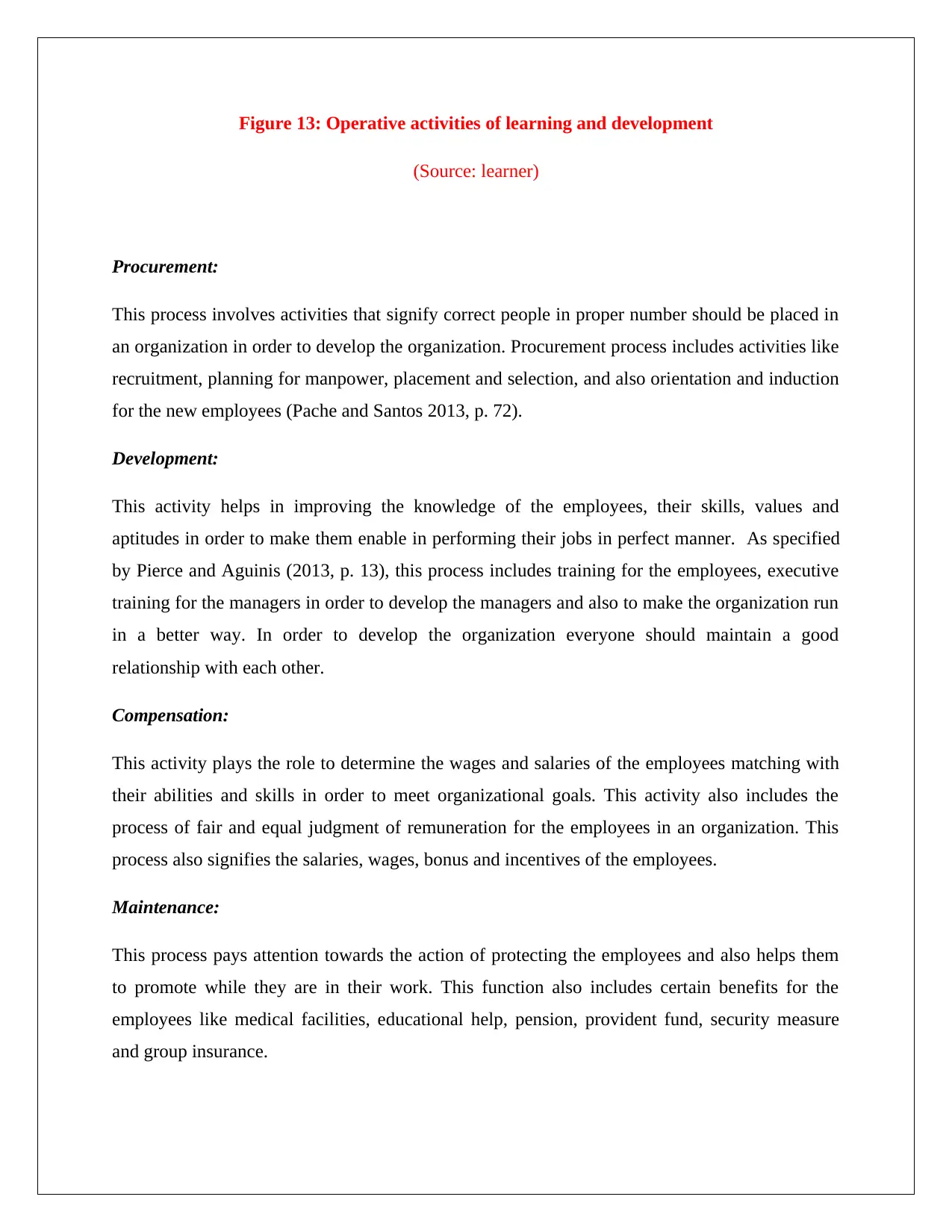
Figure 13: Operative activities of learning and development
(Source: learner)
Procurement:
This process involves activities that signify correct people in proper number should be placed in
an organization in order to develop the organization. Procurement process includes activities like
recruitment, planning for manpower, placement and selection, and also orientation and induction
for the new employees (Pache and Santos 2013, p. 72).
Development:
This activity helps in improving the knowledge of the employees, their skills, values and
aptitudes in order to make them enable in performing their jobs in perfect manner. As specified
by Pierce and Aguinis (2013, p. 13), this process includes training for the employees, executive
training for the managers in order to develop the managers and also to make the organization run
in a better way. In order to develop the organization everyone should maintain a good
relationship with each other.
Compensation:
This activity plays the role to determine the wages and salaries of the employees matching with
their abilities and skills in order to meet organizational goals. This activity also includes the
process of fair and equal judgment of remuneration for the employees in an organization. This
process also signifies the salaries, wages, bonus and incentives of the employees.
Maintenance:
This process pays attention towards the action of protecting the employees and also helps them
to promote while they are in their work. This function also includes certain benefits for the
employees like medical facilities, educational help, pension, provident fund, security measure
and group insurance.
(Source: learner)
Procurement:
This process involves activities that signify correct people in proper number should be placed in
an organization in order to develop the organization. Procurement process includes activities like
recruitment, planning for manpower, placement and selection, and also orientation and induction
for the new employees (Pache and Santos 2013, p. 72).
Development:
This activity helps in improving the knowledge of the employees, their skills, values and
aptitudes in order to make them enable in performing their jobs in perfect manner. As specified
by Pierce and Aguinis (2013, p. 13), this process includes training for the employees, executive
training for the managers in order to develop the managers and also to make the organization run
in a better way. In order to develop the organization everyone should maintain a good
relationship with each other.
Compensation:
This activity plays the role to determine the wages and salaries of the employees matching with
their abilities and skills in order to meet organizational goals. This activity also includes the
process of fair and equal judgment of remuneration for the employees in an organization. This
process also signifies the salaries, wages, bonus and incentives of the employees.
Maintenance:
This process pays attention towards the action of protecting the employees and also helps them
to promote while they are in their work. This function also includes certain benefits for the
employees like medical facilities, educational help, pension, provident fund, security measure
and group insurance.
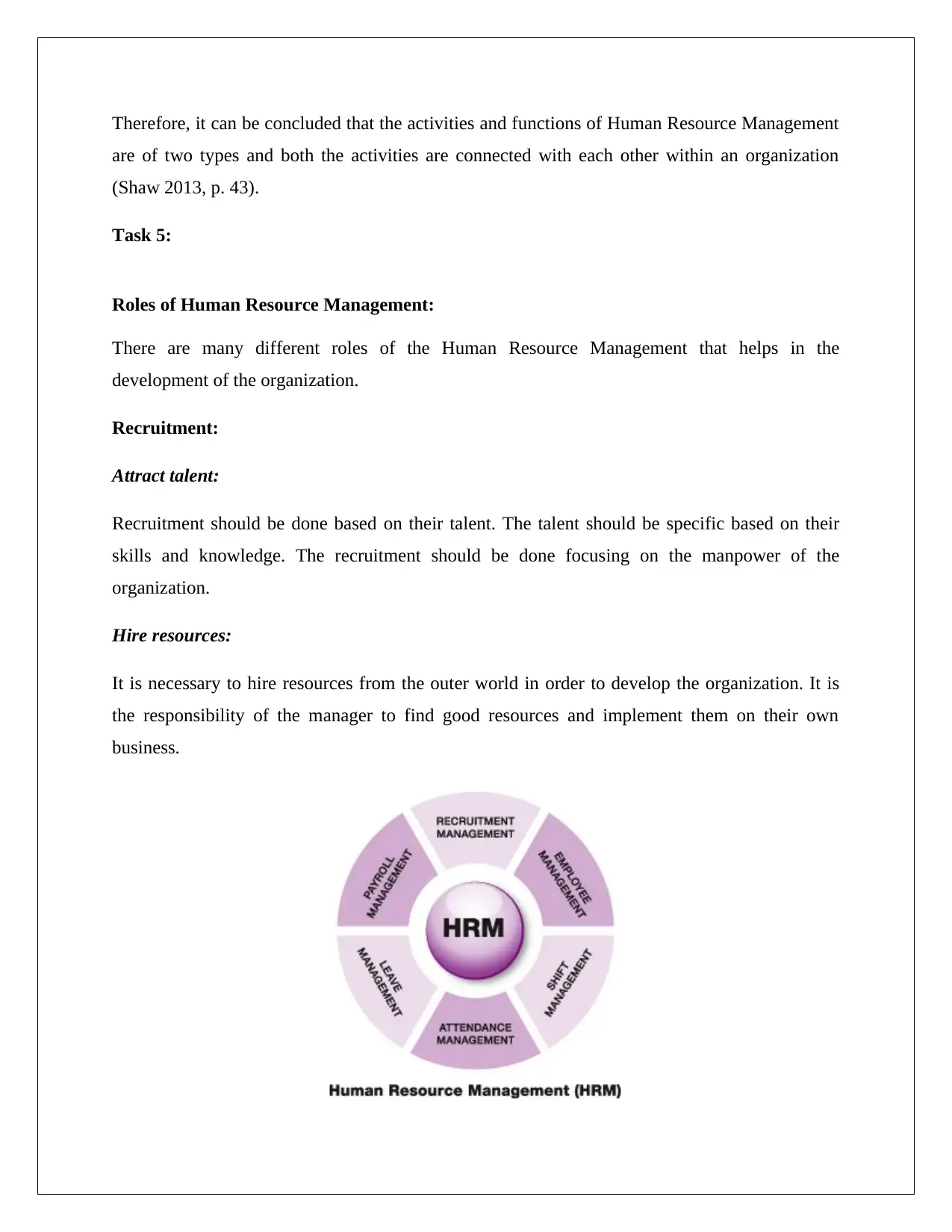
Therefore, it can be concluded that the activities and functions of Human Resource Management
are of two types and both the activities are connected with each other within an organization
(Shaw 2013, p. 43).
Task 5:
Roles of Human Resource Management:
There are many different roles of the Human Resource Management that helps in the
development of the organization.
Recruitment:
Attract talent:
Recruitment should be done based on their talent. The talent should be specific based on their
skills and knowledge. The recruitment should be done focusing on the manpower of the
organization.
Hire resources:
It is necessary to hire resources from the outer world in order to develop the organization. It is
the responsibility of the manager to find good resources and implement them on their own
business.
are of two types and both the activities are connected with each other within an organization
(Shaw 2013, p. 43).
Task 5:
Roles of Human Resource Management:
There are many different roles of the Human Resource Management that helps in the
development of the organization.
Recruitment:
Attract talent:
Recruitment should be done based on their talent. The talent should be specific based on their
skills and knowledge. The recruitment should be done focusing on the manpower of the
organization.
Hire resources:
It is necessary to hire resources from the outer world in order to develop the organization. It is
the responsibility of the manager to find good resources and implement them on their own
business.
Paraphrase This Document
Need a fresh take? Get an instant paraphrase of this document with our AI Paraphraser
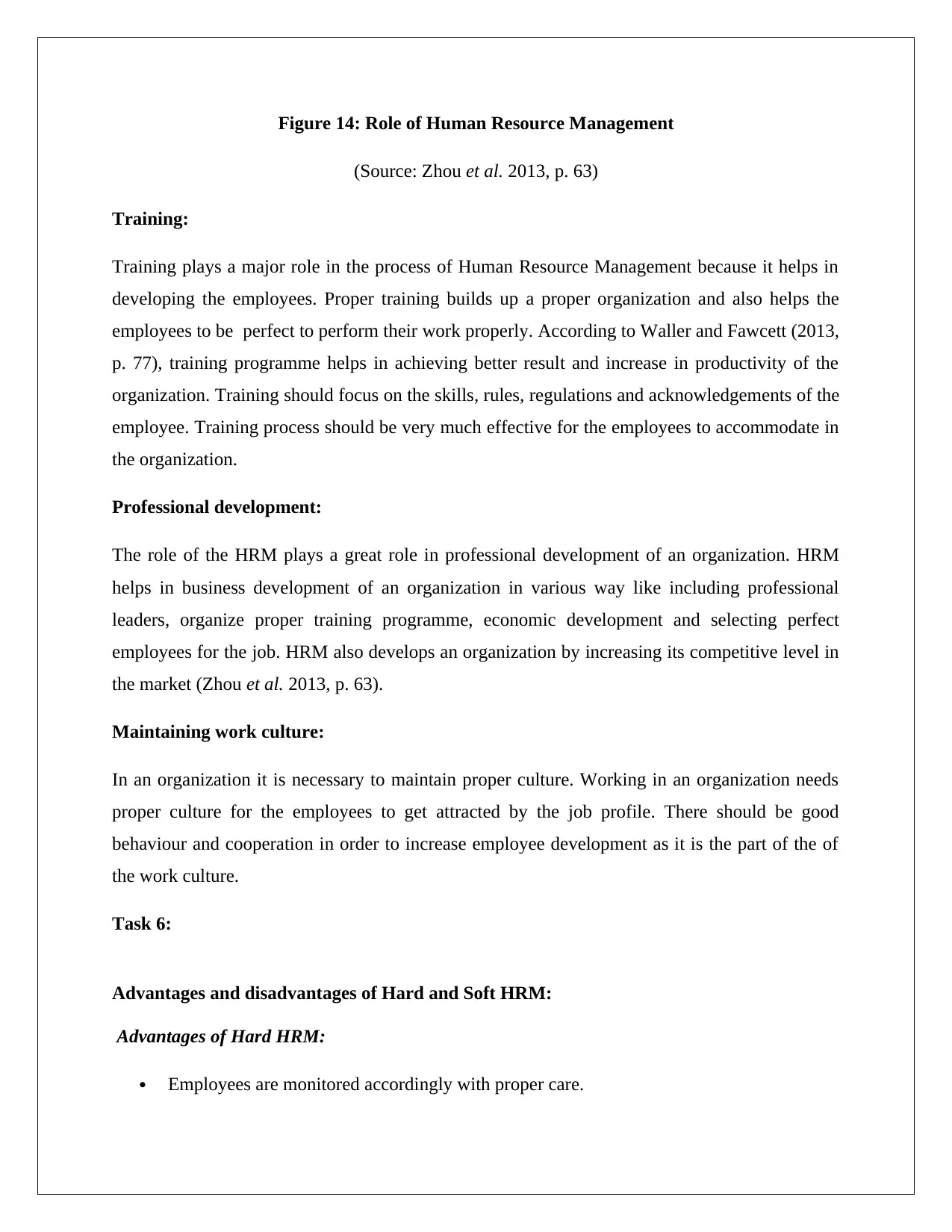
Figure 14: Role of Human Resource Management
(Source: Zhou et al. 2013, p. 63)
Training:
Training plays a major role in the process of Human Resource Management because it helps in
developing the employees. Proper training builds up a proper organization and also helps the
employees to be perfect to perform their work properly. According to Waller and Fawcett (2013,
p. 77), training programme helps in achieving better result and increase in productivity of the
organization. Training should focus on the skills, rules, regulations and acknowledgements of the
employee. Training process should be very much effective for the employees to accommodate in
the organization.
Professional development:
The role of the HRM plays a great role in professional development of an organization. HRM
helps in business development of an organization in various way like including professional
leaders, organize proper training programme, economic development and selecting perfect
employees for the job. HRM also develops an organization by increasing its competitive level in
the market (Zhou et al. 2013, p. 63).
Maintaining work culture:
In an organization it is necessary to maintain proper culture. Working in an organization needs
proper culture for the employees to get attracted by the job profile. There should be good
behaviour and cooperation in order to increase employee development as it is the part of the of
the work culture.
Task 6:
Advantages and disadvantages of Hard and Soft HRM:
Advantages of Hard HRM:
Employees are monitored accordingly with proper care.
(Source: Zhou et al. 2013, p. 63)
Training:
Training plays a major role in the process of Human Resource Management because it helps in
developing the employees. Proper training builds up a proper organization and also helps the
employees to be perfect to perform their work properly. According to Waller and Fawcett (2013,
p. 77), training programme helps in achieving better result and increase in productivity of the
organization. Training should focus on the skills, rules, regulations and acknowledgements of the
employee. Training process should be very much effective for the employees to accommodate in
the organization.
Professional development:
The role of the HRM plays a great role in professional development of an organization. HRM
helps in business development of an organization in various way like including professional
leaders, organize proper training programme, economic development and selecting perfect
employees for the job. HRM also develops an organization by increasing its competitive level in
the market (Zhou et al. 2013, p. 63).
Maintaining work culture:
In an organization it is necessary to maintain proper culture. Working in an organization needs
proper culture for the employees to get attracted by the job profile. There should be good
behaviour and cooperation in order to increase employee development as it is the part of the of
the work culture.
Task 6:
Advantages and disadvantages of Hard and Soft HRM:
Advantages of Hard HRM:
Employees are monitored accordingly with proper care.
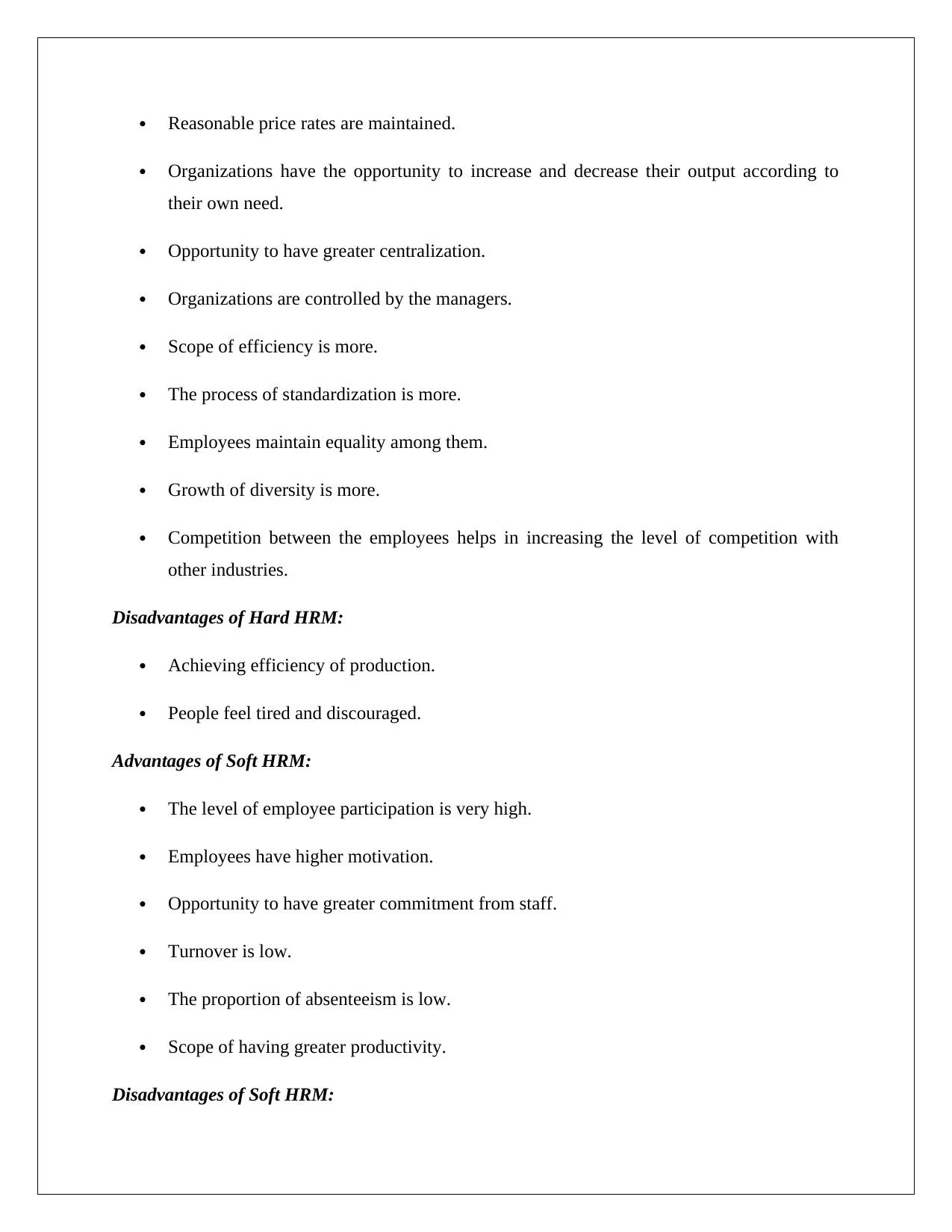
Reasonable price rates are maintained.
Organizations have the opportunity to increase and decrease their output according to
their own need.
Opportunity to have greater centralization.
Organizations are controlled by the managers.
Scope of efficiency is more.
The process of standardization is more.
Employees maintain equality among them.
Growth of diversity is more.
Competition between the employees helps in increasing the level of competition with
other industries.
Disadvantages of Hard HRM:
Achieving efficiency of production.
People feel tired and discouraged.
Advantages of Soft HRM:
The level of employee participation is very high.
Employees have higher motivation.
Opportunity to have greater commitment from staff.
Turnover is low.
The proportion of absenteeism is low.
Scope of having greater productivity.
Disadvantages of Soft HRM:
Organizations have the opportunity to increase and decrease their output according to
their own need.
Opportunity to have greater centralization.
Organizations are controlled by the managers.
Scope of efficiency is more.
The process of standardization is more.
Employees maintain equality among them.
Growth of diversity is more.
Competition between the employees helps in increasing the level of competition with
other industries.
Disadvantages of Hard HRM:
Achieving efficiency of production.
People feel tired and discouraged.
Advantages of Soft HRM:
The level of employee participation is very high.
Employees have higher motivation.
Opportunity to have greater commitment from staff.
Turnover is low.
The proportion of absenteeism is low.
Scope of having greater productivity.
Disadvantages of Soft HRM:
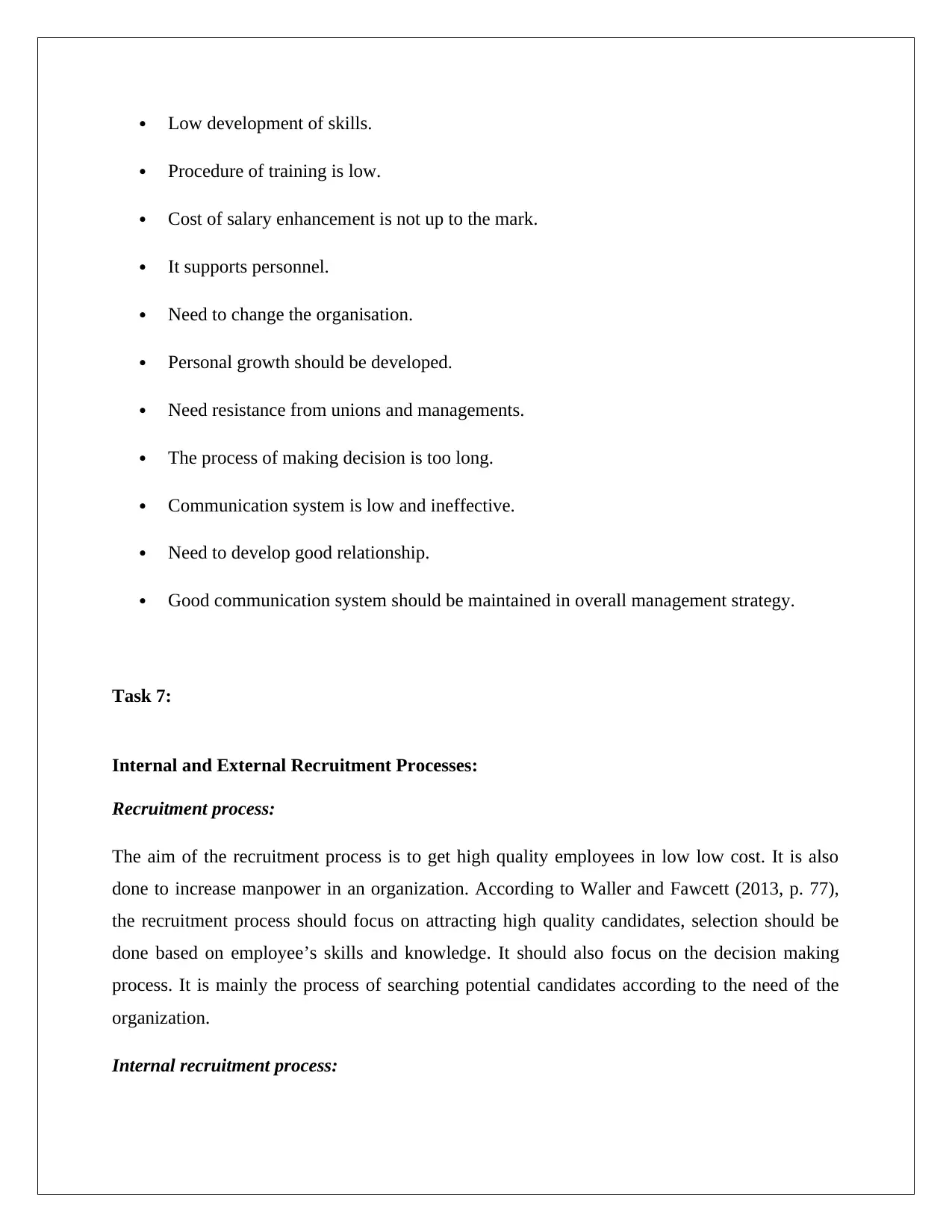
Low development of skills.
Procedure of training is low.
Cost of salary enhancement is not up to the mark.
It supports personnel.
Need to change the organisation.
Personal growth should be developed.
Need resistance from unions and managements.
The process of making decision is too long.
Communication system is low and ineffective.
Need to develop good relationship.
Good communication system should be maintained in overall management strategy.
Task 7:
Internal and External Recruitment Processes:
Recruitment process:
The aim of the recruitment process is to get high quality employees in low low cost. It is also
done to increase manpower in an organization. According to Waller and Fawcett (2013, p. 77),
the recruitment process should focus on attracting high quality candidates, selection should be
done based on employee’s skills and knowledge. It should also focus on the decision making
process. It is mainly the process of searching potential candidates according to the need of the
organization.
Internal recruitment process:
Procedure of training is low.
Cost of salary enhancement is not up to the mark.
It supports personnel.
Need to change the organisation.
Personal growth should be developed.
Need resistance from unions and managements.
The process of making decision is too long.
Communication system is low and ineffective.
Need to develop good relationship.
Good communication system should be maintained in overall management strategy.
Task 7:
Internal and External Recruitment Processes:
Recruitment process:
The aim of the recruitment process is to get high quality employees in low low cost. It is also
done to increase manpower in an organization. According to Waller and Fawcett (2013, p. 77),
the recruitment process should focus on attracting high quality candidates, selection should be
done based on employee’s skills and knowledge. It should also focus on the decision making
process. It is mainly the process of searching potential candidates according to the need of the
organization.
Internal recruitment process:
Secure Best Marks with AI Grader
Need help grading? Try our AI Grader for instant feedback on your assignments.
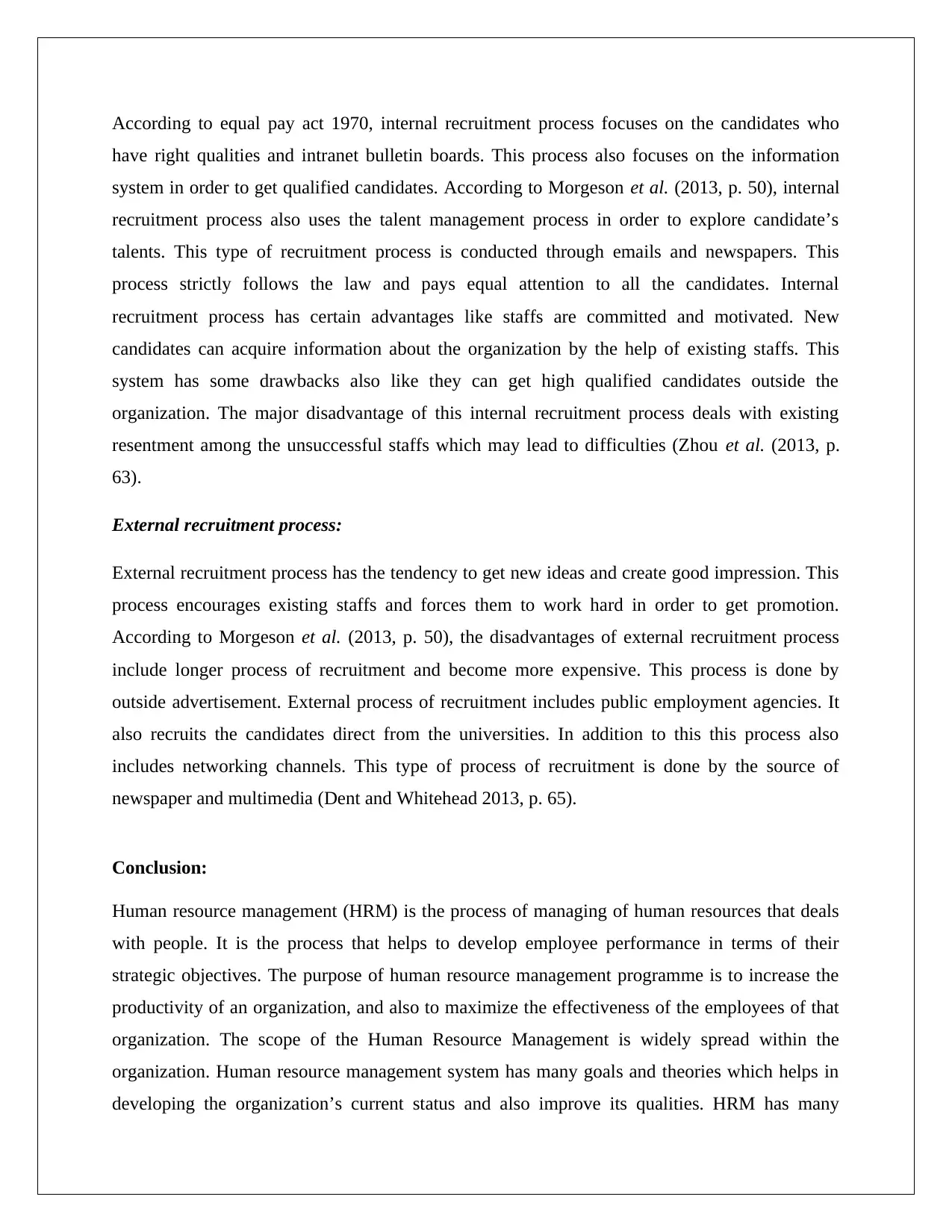
According to equal pay act 1970, internal recruitment process focuses on the candidates who
have right qualities and intranet bulletin boards. This process also focuses on the information
system in order to get qualified candidates. According to Morgeson et al. (2013, p. 50), internal
recruitment process also uses the talent management process in order to explore candidate’s
talents. This type of recruitment process is conducted through emails and newspapers. This
process strictly follows the law and pays equal attention to all the candidates. Internal
recruitment process has certain advantages like staffs are committed and motivated. New
candidates can acquire information about the organization by the help of existing staffs. This
system has some drawbacks also like they can get high qualified candidates outside the
organization. The major disadvantage of this internal recruitment process deals with existing
resentment among the unsuccessful staffs which may lead to difficulties (Zhou et al. (2013, p.
63).
External recruitment process:
External recruitment process has the tendency to get new ideas and create good impression. This
process encourages existing staffs and forces them to work hard in order to get promotion.
According to Morgeson et al. (2013, p. 50), the disadvantages of external recruitment process
include longer process of recruitment and become more expensive. This process is done by
outside advertisement. External process of recruitment includes public employment agencies. It
also recruits the candidates direct from the universities. In addition to this this process also
includes networking channels. This type of process of recruitment is done by the source of
newspaper and multimedia (Dent and Whitehead 2013, p. 65).
Conclusion:
Human resource management (HRM) is the process of managing of human resources that deals
with people. It is the process that helps to develop employee performance in terms of their
strategic objectives. The purpose of human resource management programme is to increase the
productivity of an organization, and also to maximize the effectiveness of the employees of that
organization. The scope of the Human Resource Management is widely spread within the
organization. Human resource management system has many goals and theories which helps in
developing the organization’s current status and also improve its qualities. HRM has many
have right qualities and intranet bulletin boards. This process also focuses on the information
system in order to get qualified candidates. According to Morgeson et al. (2013, p. 50), internal
recruitment process also uses the talent management process in order to explore candidate’s
talents. This type of recruitment process is conducted through emails and newspapers. This
process strictly follows the law and pays equal attention to all the candidates. Internal
recruitment process has certain advantages like staffs are committed and motivated. New
candidates can acquire information about the organization by the help of existing staffs. This
system has some drawbacks also like they can get high qualified candidates outside the
organization. The major disadvantage of this internal recruitment process deals with existing
resentment among the unsuccessful staffs which may lead to difficulties (Zhou et al. (2013, p.
63).
External recruitment process:
External recruitment process has the tendency to get new ideas and create good impression. This
process encourages existing staffs and forces them to work hard in order to get promotion.
According to Morgeson et al. (2013, p. 50), the disadvantages of external recruitment process
include longer process of recruitment and become more expensive. This process is done by
outside advertisement. External process of recruitment includes public employment agencies. It
also recruits the candidates direct from the universities. In addition to this this process also
includes networking channels. This type of process of recruitment is done by the source of
newspaper and multimedia (Dent and Whitehead 2013, p. 65).
Conclusion:
Human resource management (HRM) is the process of managing of human resources that deals
with people. It is the process that helps to develop employee performance in terms of their
strategic objectives. The purpose of human resource management programme is to increase the
productivity of an organization, and also to maximize the effectiveness of the employees of that
organization. The scope of the Human Resource Management is widely spread within the
organization. Human resource management system has many goals and theories which helps in
developing the organization’s current status and also improve its qualities. HRM has many
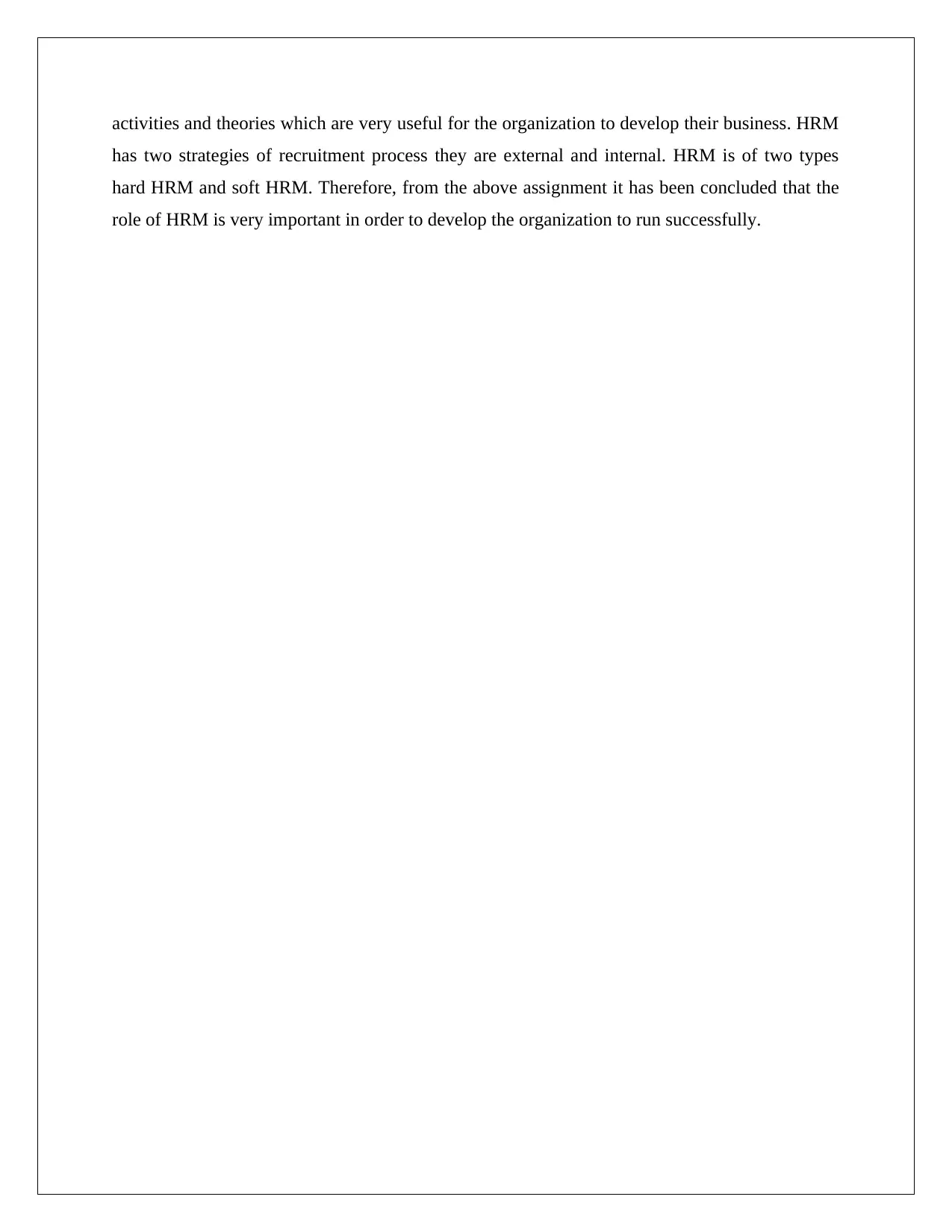
activities and theories which are very useful for the organization to develop their business. HRM
has two strategies of recruitment process they are external and internal. HRM is of two types
hard HRM and soft HRM. Therefore, from the above assignment it has been concluded that the
role of HRM is very important in order to develop the organization to run successfully.
has two strategies of recruitment process they are external and internal. HRM is of two types
hard HRM and soft HRM. Therefore, from the above assignment it has been concluded that the
role of HRM is very important in order to develop the organization to run successfully.
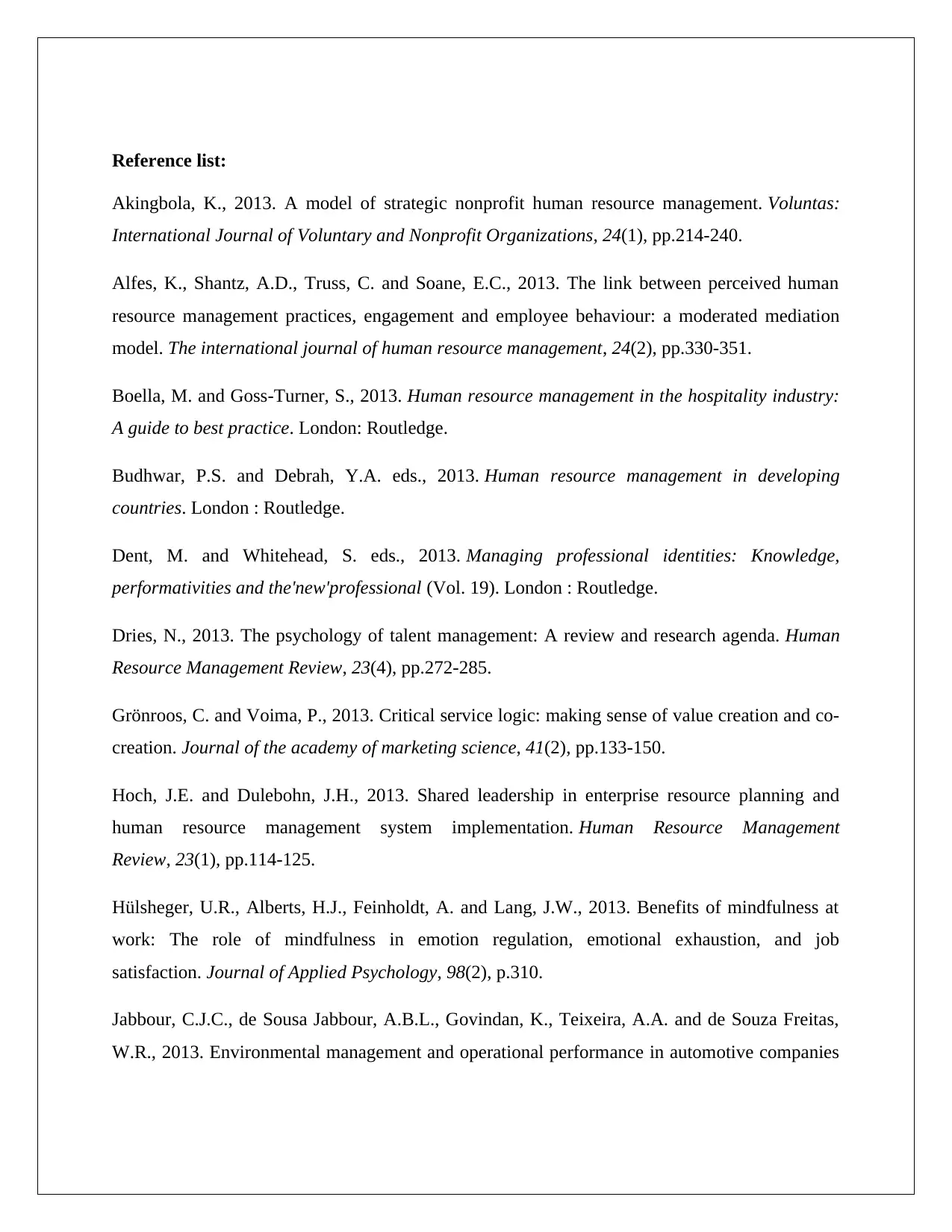
Reference list:
Akingbola, K., 2013. A model of strategic nonprofit human resource management. Voluntas:
International Journal of Voluntary and Nonprofit Organizations, 24(1), pp.214-240.
Alfes, K., Shantz, A.D., Truss, C. and Soane, E.C., 2013. The link between perceived human
resource management practices, engagement and employee behaviour: a moderated mediation
model. The international journal of human resource management, 24(2), pp.330-351.
Boella, M. and Goss-Turner, S., 2013. Human resource management in the hospitality industry:
A guide to best practice. London: Routledge.
Budhwar, P.S. and Debrah, Y.A. eds., 2013. Human resource management in developing
countries. London : Routledge.
Dent, M. and Whitehead, S. eds., 2013. Managing professional identities: Knowledge,
performativities and the'new'professional (Vol. 19). London : Routledge.
Dries, N., 2013. The psychology of talent management: A review and research agenda. Human
Resource Management Review, 23(4), pp.272-285.
Grönroos, C. and Voima, P., 2013. Critical service logic: making sense of value creation and co-
creation. Journal of the academy of marketing science, 41(2), pp.133-150.
Hoch, J.E. and Dulebohn, J.H., 2013. Shared leadership in enterprise resource planning and
human resource management system implementation. Human Resource Management
Review, 23(1), pp.114-125.
Hülsheger, U.R., Alberts, H.J., Feinholdt, A. and Lang, J.W., 2013. Benefits of mindfulness at
work: The role of mindfulness in emotion regulation, emotional exhaustion, and job
satisfaction. Journal of Applied Psychology, 98(2), p.310.
Jabbour, C.J.C., de Sousa Jabbour, A.B.L., Govindan, K., Teixeira, A.A. and de Souza Freitas,
W.R., 2013. Environmental management and operational performance in automotive companies
Akingbola, K., 2013. A model of strategic nonprofit human resource management. Voluntas:
International Journal of Voluntary and Nonprofit Organizations, 24(1), pp.214-240.
Alfes, K., Shantz, A.D., Truss, C. and Soane, E.C., 2013. The link between perceived human
resource management practices, engagement and employee behaviour: a moderated mediation
model. The international journal of human resource management, 24(2), pp.330-351.
Boella, M. and Goss-Turner, S., 2013. Human resource management in the hospitality industry:
A guide to best practice. London: Routledge.
Budhwar, P.S. and Debrah, Y.A. eds., 2013. Human resource management in developing
countries. London : Routledge.
Dent, M. and Whitehead, S. eds., 2013. Managing professional identities: Knowledge,
performativities and the'new'professional (Vol. 19). London : Routledge.
Dries, N., 2013. The psychology of talent management: A review and research agenda. Human
Resource Management Review, 23(4), pp.272-285.
Grönroos, C. and Voima, P., 2013. Critical service logic: making sense of value creation and co-
creation. Journal of the academy of marketing science, 41(2), pp.133-150.
Hoch, J.E. and Dulebohn, J.H., 2013. Shared leadership in enterprise resource planning and
human resource management system implementation. Human Resource Management
Review, 23(1), pp.114-125.
Hülsheger, U.R., Alberts, H.J., Feinholdt, A. and Lang, J.W., 2013. Benefits of mindfulness at
work: The role of mindfulness in emotion regulation, emotional exhaustion, and job
satisfaction. Journal of Applied Psychology, 98(2), p.310.
Jabbour, C.J.C., de Sousa Jabbour, A.B.L., Govindan, K., Teixeira, A.A. and de Souza Freitas,
W.R., 2013. Environmental management and operational performance in automotive companies
Paraphrase This Document
Need a fresh take? Get an instant paraphrase of this document with our AI Paraphraser
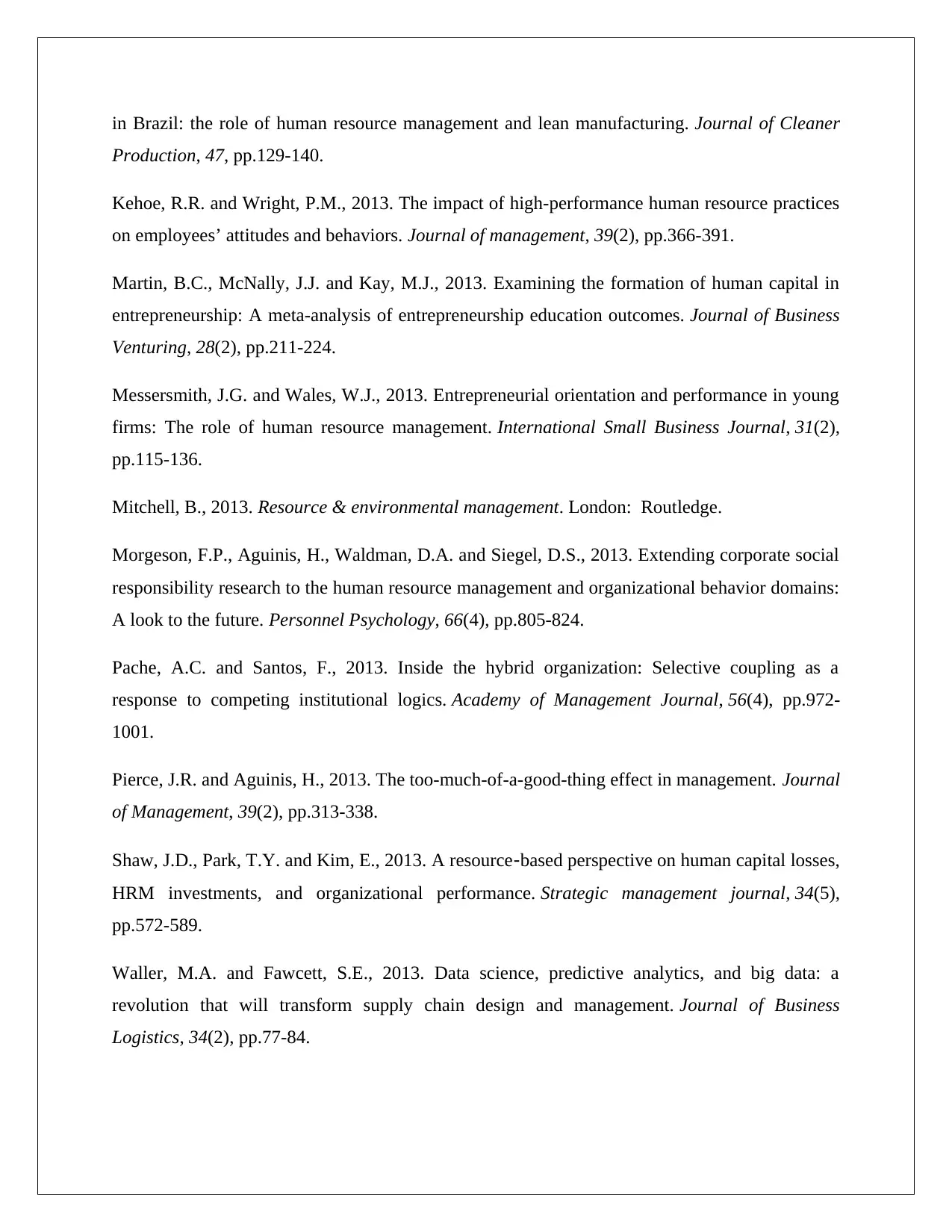
in Brazil: the role of human resource management and lean manufacturing. Journal of Cleaner
Production, 47, pp.129-140.
Kehoe, R.R. and Wright, P.M., 2013. The impact of high-performance human resource practices
on employees’ attitudes and behaviors. Journal of management, 39(2), pp.366-391.
Martin, B.C., McNally, J.J. and Kay, M.J., 2013. Examining the formation of human capital in
entrepreneurship: A meta-analysis of entrepreneurship education outcomes. Journal of Business
Venturing, 28(2), pp.211-224.
Messersmith, J.G. and Wales, W.J., 2013. Entrepreneurial orientation and performance in young
firms: The role of human resource management. International Small Business Journal, 31(2),
pp.115-136.
Mitchell, B., 2013. Resource & environmental management. London: Routledge.
Morgeson, F.P., Aguinis, H., Waldman, D.A. and Siegel, D.S., 2013. Extending corporate social
responsibility research to the human resource management and organizational behavior domains:
A look to the future. Personnel Psychology, 66(4), pp.805-824.
Pache, A.C. and Santos, F., 2013. Inside the hybrid organization: Selective coupling as a
response to competing institutional logics. Academy of Management Journal, 56(4), pp.972-
1001.
Pierce, J.R. and Aguinis, H., 2013. The too-much-of-a-good-thing effect in management. Journal
of Management, 39(2), pp.313-338.
Shaw, J.D., Park, T.Y. and Kim, E., 2013. A resource‐based perspective on human capital losses,
HRM investments, and organizational performance. Strategic management journal, 34(5),
pp.572-589.
Waller, M.A. and Fawcett, S.E., 2013. Data science, predictive analytics, and big data: a
revolution that will transform supply chain design and management. Journal of Business
Logistics, 34(2), pp.77-84.
Production, 47, pp.129-140.
Kehoe, R.R. and Wright, P.M., 2013. The impact of high-performance human resource practices
on employees’ attitudes and behaviors. Journal of management, 39(2), pp.366-391.
Martin, B.C., McNally, J.J. and Kay, M.J., 2013. Examining the formation of human capital in
entrepreneurship: A meta-analysis of entrepreneurship education outcomes. Journal of Business
Venturing, 28(2), pp.211-224.
Messersmith, J.G. and Wales, W.J., 2013. Entrepreneurial orientation and performance in young
firms: The role of human resource management. International Small Business Journal, 31(2),
pp.115-136.
Mitchell, B., 2013. Resource & environmental management. London: Routledge.
Morgeson, F.P., Aguinis, H., Waldman, D.A. and Siegel, D.S., 2013. Extending corporate social
responsibility research to the human resource management and organizational behavior domains:
A look to the future. Personnel Psychology, 66(4), pp.805-824.
Pache, A.C. and Santos, F., 2013. Inside the hybrid organization: Selective coupling as a
response to competing institutional logics. Academy of Management Journal, 56(4), pp.972-
1001.
Pierce, J.R. and Aguinis, H., 2013. The too-much-of-a-good-thing effect in management. Journal
of Management, 39(2), pp.313-338.
Shaw, J.D., Park, T.Y. and Kim, E., 2013. A resource‐based perspective on human capital losses,
HRM investments, and organizational performance. Strategic management journal, 34(5),
pp.572-589.
Waller, M.A. and Fawcett, S.E., 2013. Data science, predictive analytics, and big data: a
revolution that will transform supply chain design and management. Journal of Business
Logistics, 34(2), pp.77-84.
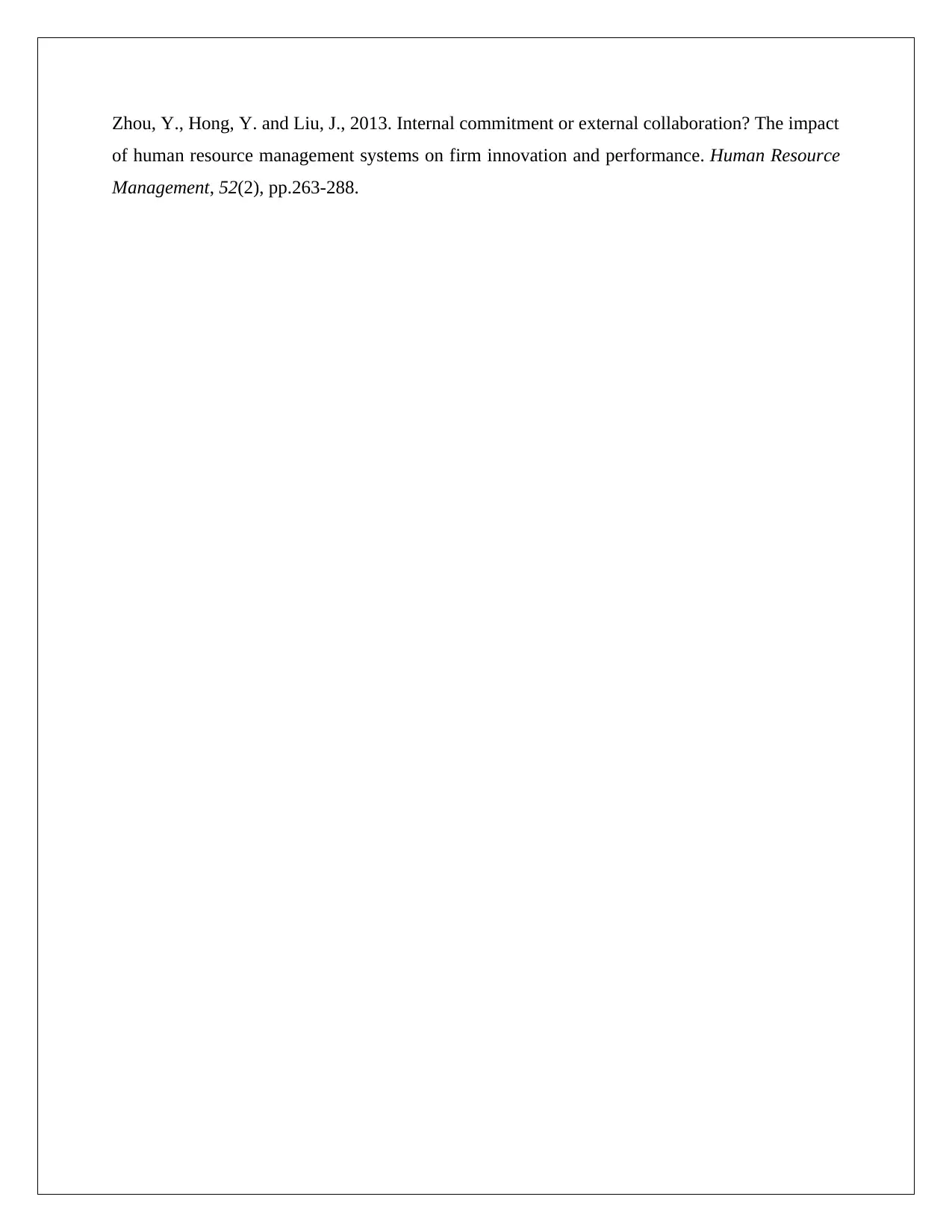
Zhou, Y., Hong, Y. and Liu, J., 2013. Internal commitment or external collaboration? The impact
of human resource management systems on firm innovation and performance. Human Resource
Management, 52(2), pp.263-288.
of human resource management systems on firm innovation and performance. Human Resource
Management, 52(2), pp.263-288.
1 out of 27
Related Documents
Your All-in-One AI-Powered Toolkit for Academic Success.
+13062052269
info@desklib.com
Available 24*7 on WhatsApp / Email
![[object Object]](/_next/static/media/star-bottom.7253800d.svg)
Unlock your academic potential
© 2024 | Zucol Services PVT LTD | All rights reserved.





